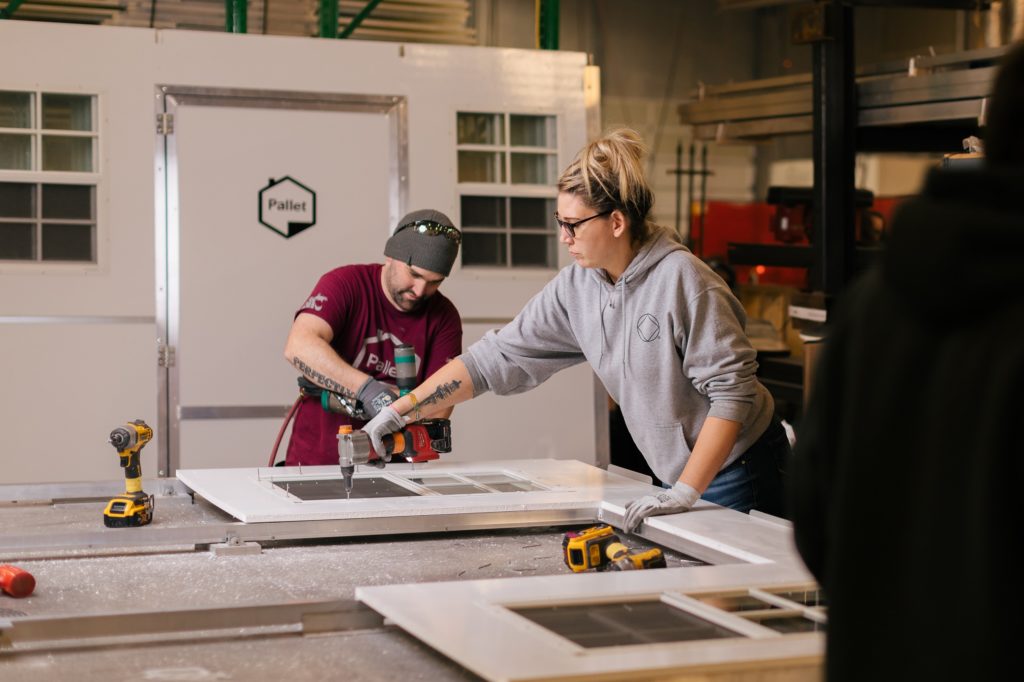
Pallet's nontraditional workforce is an integral part of our success. Temporary shelters are the foundation of our people-first restorative communities across the country for unhoused people. Because our team members have lived experience in homelessness, Pallet makes a product that uniquely meets the needs of people who have been living on the street. Their input is essential.
As a second chance friendly employer, we believe potential — not the past — defines people's futures. More than 80% of our employees are formerly homeless, in recovery, or previously involved in the justice system. (*We now describe our hiring practices as fair chance employment. Learn why we changed our language here.)
People who have had to live outside, navigate the prison system, or recover from substance use disorder have incredible survival tactics, are resilient and intelligent. Amy King, Pallet founder and CEO, says those skill sets can be repurposed, “The best possible candidate on paper is not always the best possible candidate for your culture, for what you want to do, for your mission, for your vision and your values. And it could be that you need a little bit of both. You need some that are really skilled, and then you need some really creative people.”
Amy has shared her expertise with companies considering tapping into this hidden workforce. Here are her five tips to get started:
#1 Hire in groups, not just one person
An employer may prefer to "test the waters" of being a second chance employer by starting with a pilot program. Amy cautions against this.
"It's not going to work because you've singled them out. There's one single person with this diverse background. They're all alone in the workplace, and people aren't stupid. They're going to know where they come from, and they're going to understand kind of why they're different, and they're going to get singled out. That's just human nature. It's unfortunate, but it's true."
#2 Hire for management, not solely entry-level positions
"One of our biggest keys to success here has been elevating people with lived experience to positions of leadership and authority. So that someone coming in at an entry-level position sees someone like them on the board, in the leadership position, as a manager, supervisor. And they say, 'Oh, that person's like me, and they're my boss, or they're my boss's boss or whatever the case might be.' I think that's critical to success."
#3 Create a flexible staffing strategy
Suppose an employer hires people who have recently exited the criminal justice system. In that case, they need to utilize a staffing strategy that allows for unplanned absences. For example, this type of employee may need to complete court-ordered requirements such as outpatient treatment, parenting classes, or drug testing. Because these requirements often occur during business hours, the employee will need to be away with the confidence that it won't put their job at risk. Employers should accommodate these population-specific needs.
Amy first encountered this particular challenge at Square Peg Construction, a general contracting company she co-founded with her husband, Brady.
"Instead of fighting it, we said, 'Let's just accommodate for that.' We overstaffed so that if someone was gone, we could still perform on our schedule. In other words, we created the staffing strategy in such a way that we could still complete our work on time, on budget, regardless of ten percent of people being out of office."
#4 Create an inclusive environment
"Inclusive in the sense that you've created a space where people can feel welcome and comfortable. They can be themselves wholly and completely in their place of employment and not feel like they have to conform to whatever that environment is, which is not traditional corporate culture."
Acceptance is a crucial component and an understanding that everyone didn't have access to the same opportunities.
#5 Prepare to apply for tax credits
Federal and state tax credits are available to employers who hire people from groups who face significant barriers to employment. Pallet utilizes the Work Opportunity Tax Credit, a federal program. The credit ranges from $1,200 to $9,600 depending on the targeted group hired, including formerly incarcerated people, vocational rehabilitation referrals, and Supplemental Nutrition Assistance Program (SNAP) recipients.
Pallet uses the tax credit to fund programs and services provided to staff, such as manufacturing training, life skills training, and personal support services.
Tax credit aside, Amy says using diversified hiring practices makes Pallet a versatile company. Bringing in people who can process and problem solve with compassion, sensitivity, and creativity is vital.
Part II: FAQ’s about becoming a second chance employer
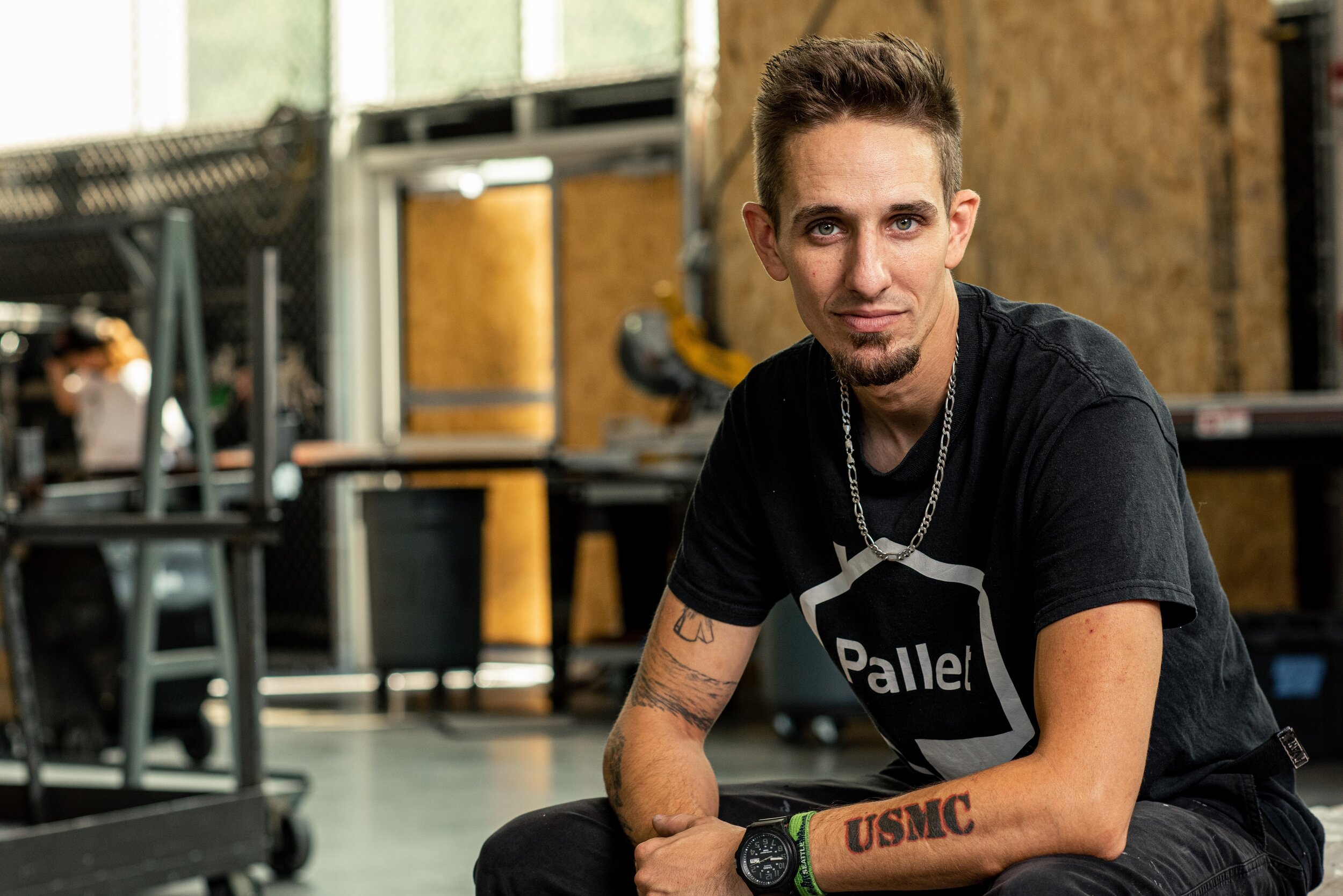
A.J., Pallet manufacturing specialist
Content warning: The following post briefly discusses suicide
For more than a year, A.J. has worked on the Pallet team as a manufacturing specialist. He has an abundance of energy, is adventurous, and doesn't shy away from a challenge. He embraces difficulty and uses it to better himself.
When A.J. is building shelters for people experiencing homelessness, he's most likely listening to a self-help book.
"If I really like it, I'll order it," said A.J. "But I've already basically read it three times before I order it."
One of his favorites is Jen Sincero's "You Are a Badass: How to Stop Doubting Your Greatness and Start Living an Awesome Life." Diving into the self-help genre is part of his overall effort to make life changes. A therapist is also guiding him with this effort. A.J. sought help because he was in a cycle he described as "work, bills, stress, worry, problems, and suicidal thoughts." The therapist is helping him step outside of that and work on other aspects of his life.
"Therapy is helping a lot. It keeps me constantly engaged in myself," said A.J. "How do I better myself? That never popped up. I was never taught how to do that, nor manage my emotions when I was a kid."
A.J. grew up in the greater Seattle area and enjoyed participating in sports. He proudly talks about playing basketball, soccer, and cross country running. After graduating high school, he joined the U.S. Marines. He served for three and half years then returned home.
He worked as an electrician with a family member and did well for a while. But he began taking opiates and later harder substances. A.J. says his life quickly went downhill. He tried to stop a few times but was unsuccessful. Growing up, he experienced trauma, had anxiety and ADHD.
A.J. says substance use disorder was destroying his life and strained his relationship with his mother.
"You spend all day trying to figure out how to get this or begging or pleading or stealing or something. And then you finally get it, and then the rest of the day is spent using it to wake up to start that process over again," said A.J. "You can't think of anything else because you're in so much pain, agony, stress in the mind. You think you're going to die, which you don't, but you feel like you're going to."
In January 2019, he checked into Olalla Guest Lodge for treatment. He was ready to begin a life in recovery.
The following year A.J. joined Pallet. While he was never homeless for more than a couple of nights at a time, he was friends with people who were. Making shelter for those in need is a way to give back. "I empathize with them greatly. If I see someone, here's two three bucks, whatever I can. If I can't, I'll find something else, something to make their day."
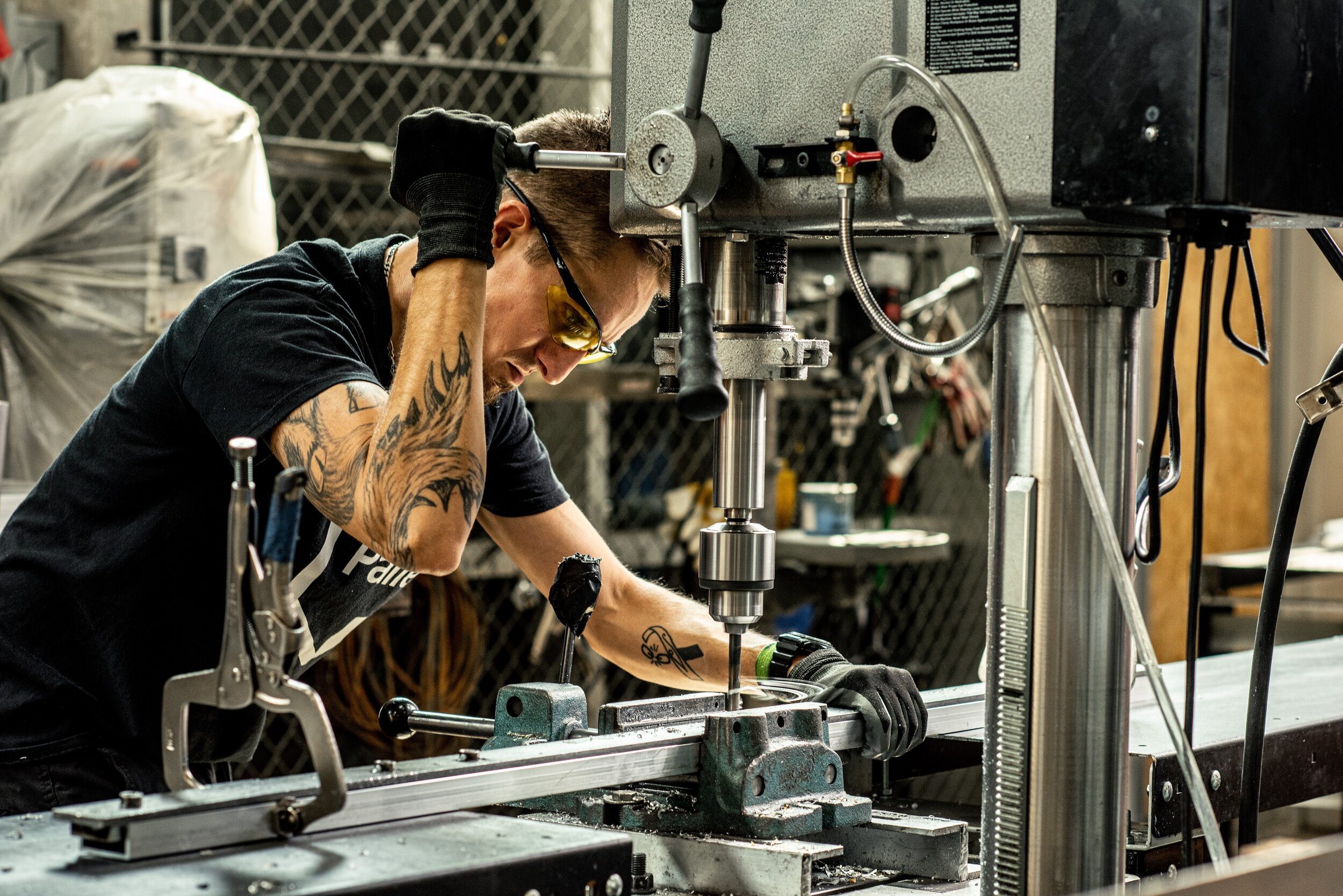
A.J. working on the drill press.
A.J. enjoys his role at Pallet and says his coworkers are like family– in part because there's an immediate understanding of the path that led him here. Because he works with many others with a similar background, he doesn't have to hide his past struggles or worry about becoming an outcast.
He explains why judgment of people like him who have faced challenges in life is unwarranted. "You're human just like me. Made mistakes just like me. I made different ones. That doesn't make you better than me. It just means you tripped over different rocks than I did. It just means my rock was a lot bigger."
When asked where he sees himself three years from now, A.J. prefers to focus on the present — meeting financial goals and continuing his personal growth. Eventually, he does want to get his license back so he can be an electrician.
Pallet is a second chance friendly company. No resume is required because we believe potential, not history, defines people’s futures.
RELATED POSTS:
Debunking homelessness myths: They are not local
Profile: Chris Hernandez, Chandler Street Tiny Home Village case manager
Pallet Founder and CEO Amy King talks building shelter for people experiencing homelessness and more in podcast interview
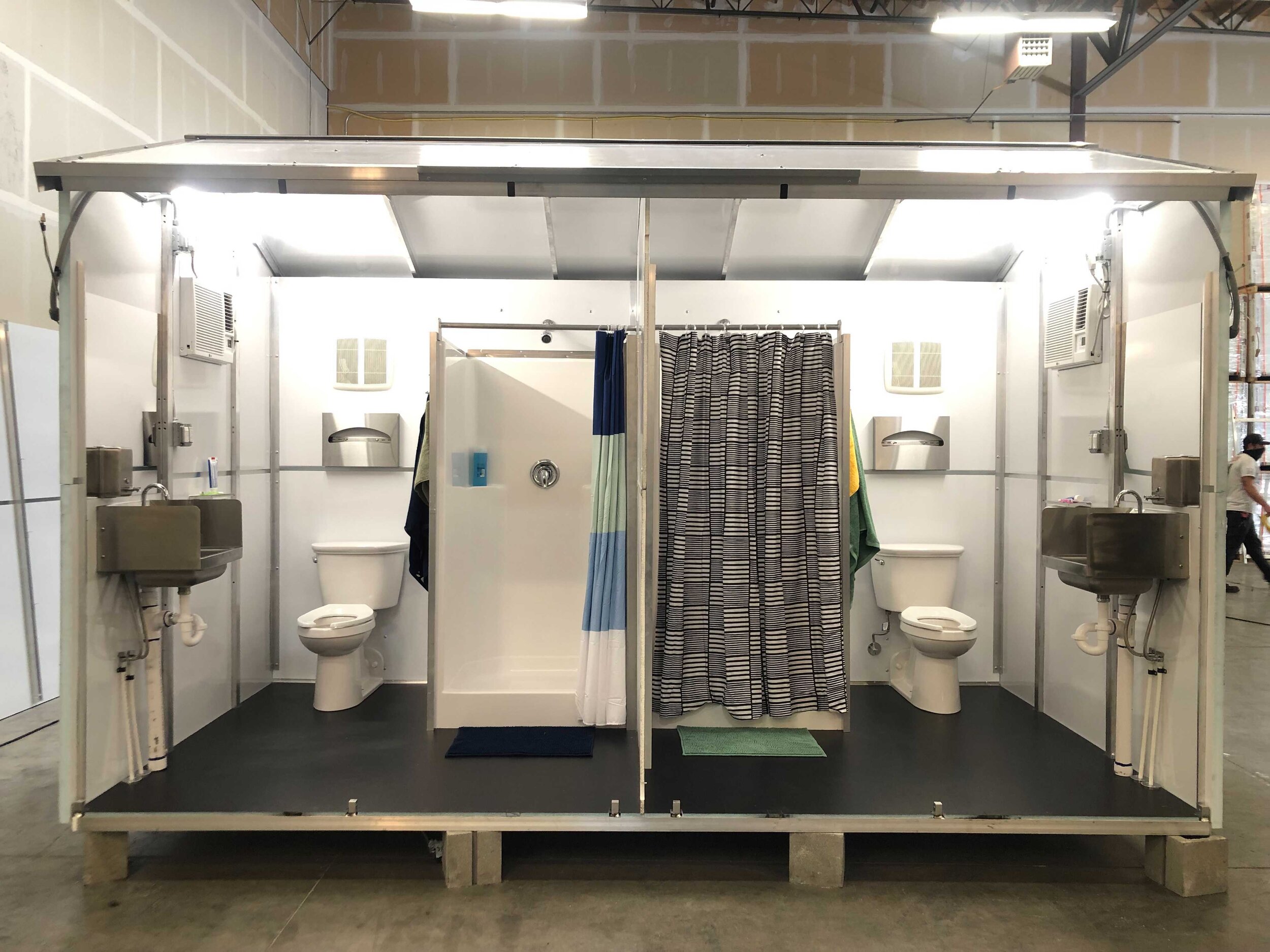
One of five Pallet bathroom configurations in the finalization process at our research and development factory.
Ensuring Pallet Shelter Village residents have access to bathrooms is an integral part of our community model, along with on-site social services. Having a safe, private space for hygienic needs is one element of our commitment to creating a dignified community for people experiencing homelessness. We're excited to announce Pallet's engineering team has designed a series of bathrooms for communities. Five designs include various combinations of a sink, toilet, and shower. A tankless water heater assures that hot water will be readily available.
The new bathrooms are an evolution of our 64 sq. ft. and 100 sq. ft. sleeping cabins. The same material is used for the structure, aluminum framing and walls composed of fiberglass reinforced plastic with a foam insulating core. The team modified the basic structural design to meet its new purpose. This approach allowed our engineers to move quickly to meet this need.
"We didn't have to start over to redesign the bathrooms. If we were designing each of these from a clean sheet of paper, it would have taken us three years to design five different units," explained Zane Geel, Pallet's Director of Engineering. Instead, by using the same basic structure the design process took about six months.
The sleeping shelters were easily converted to bathrooms by increasing the number of doors on the front wall to access individual stalls, and eliminating windows for privacy during use. There's also an inner back wall for the installation of plumbing and electrical wiring. This way, the outer back wall can be removed for our team’s inspection and maintenance, and the entire structure will stay intact. The removable wall also gives inspectors easy access to review the plumbing and electrical system if necessary.
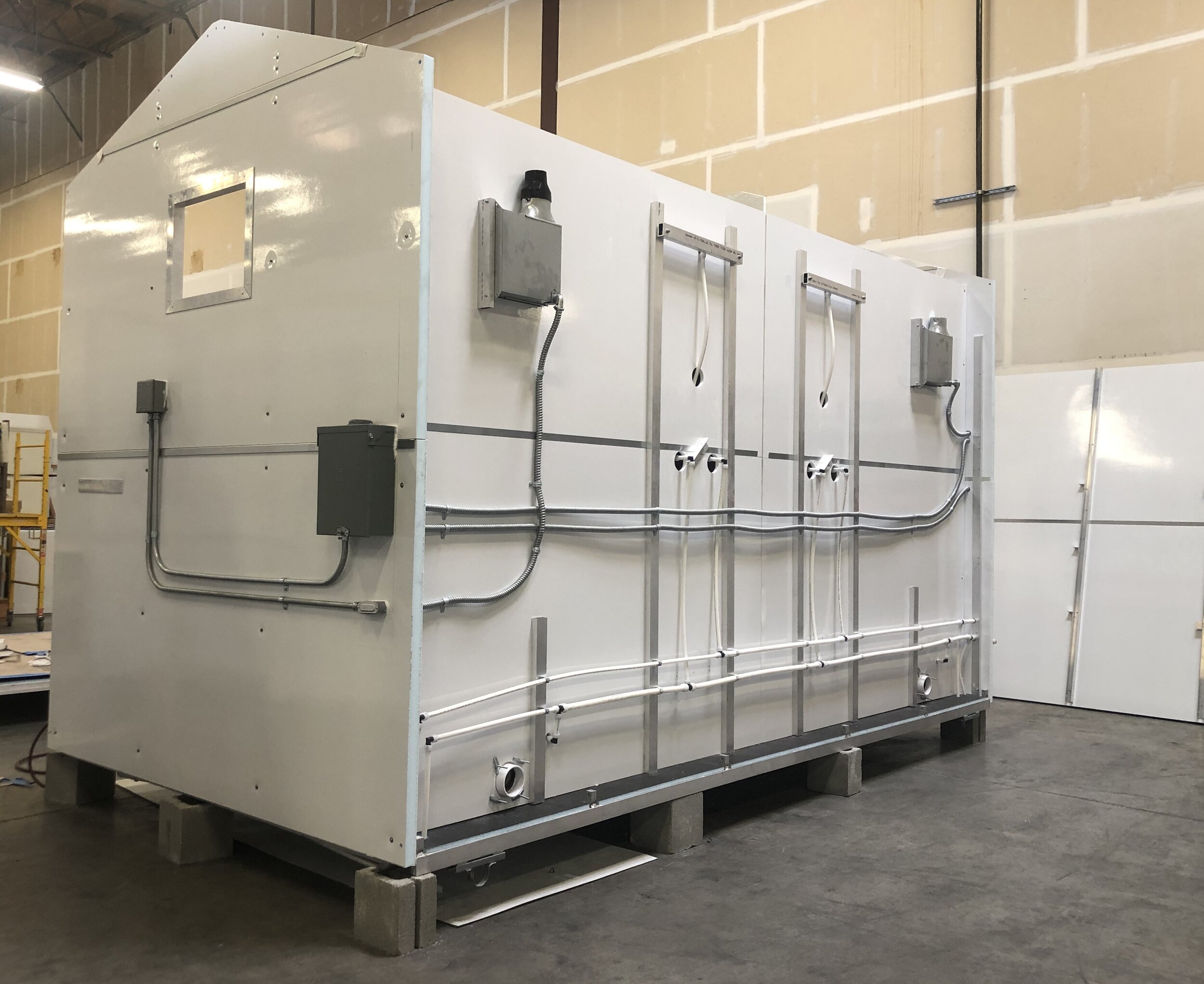
View of a bathroom unit inside our factory with the outer back wall removed to show the inner back wall’s plumbing and electricity.
As a part of the initial design process, we installed a unit with multiple sink, toilet, and shower configurations at Skagit First Step Center in Burlington, WA. Residents are using them now and recently provided the team with valuable feedback about how its performing.
"We went through a survey and asked them all these questions, things like, is the lighting adequate? Is there always hot water available? Do you have any trouble with the toilets? Is the sink the right height?" said Zane. "Overall, it's performing very well. They love the products."
The assembly of the bathrooms differs from our shelters. When the sleeping cabins are shipped, they are stacked and panelized on a pallet then assembled on-site by a team. However, the bathrooms are completely built at our factory, then shipped to a community. This process significantly simplifies installation.
By offering bathrooms, creating a Pallet Shelter Village is more streamlined; it eliminates the need to find multiple separate suppliers.
"I think another one of the advantages of a customer coming to us is you get the consistency of look," said Zane. "We can provide a single quote, a single deployment that provides all of the functions that they need, which makes it way easier for the municipality."
Other accessory units in development include an ADA bathroom, community center, and laundry facility that will hold five stackable washers and dryers.
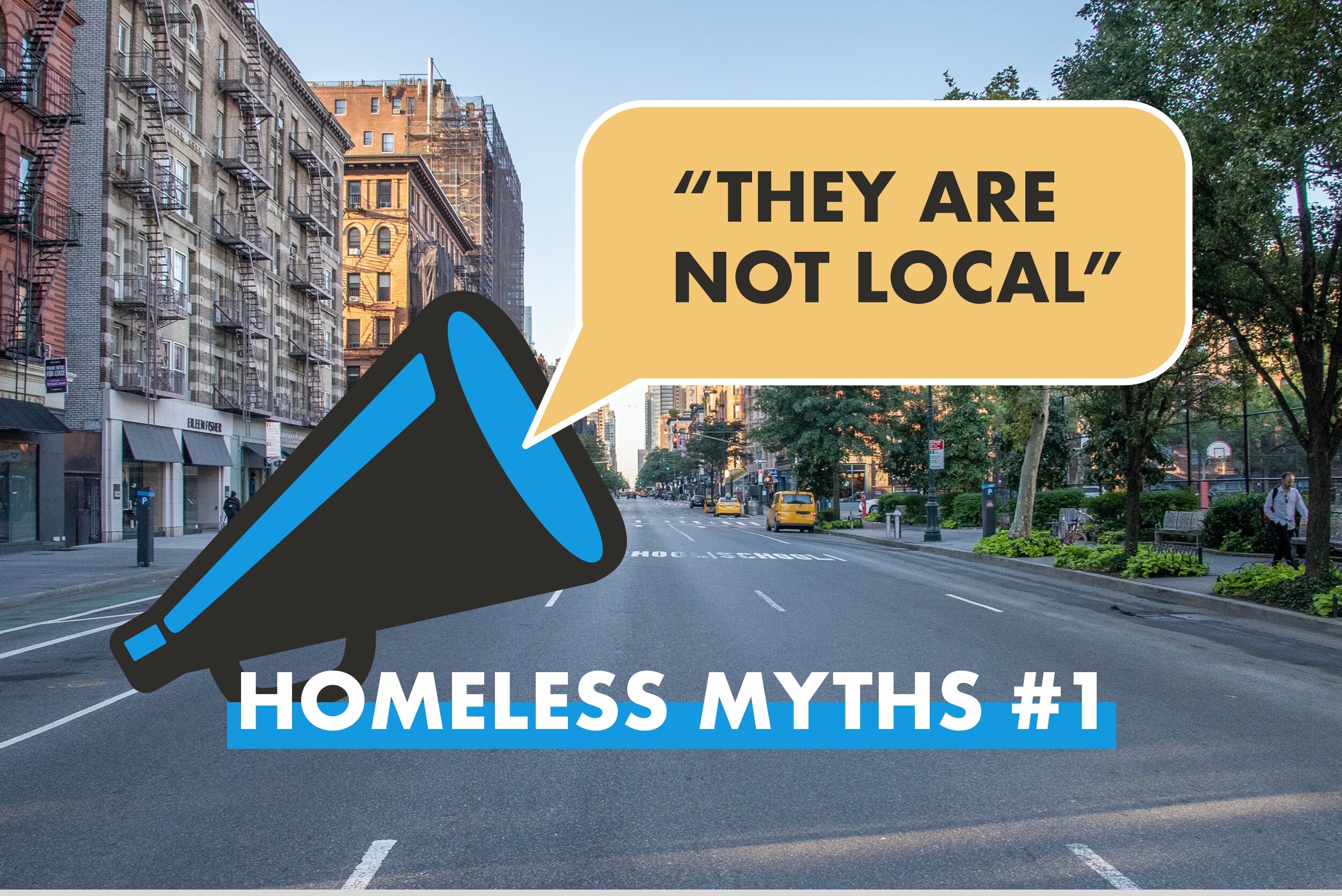
While the myths surrounding homelessness may seem benign, they can have real consequences for unhoused people. Public perception helps shape public policy. When we believe the worst about our homeless neighbors, they aren't shown the compassion and dignity they deserve. Getting back on the path to stability requires support that we should be eager to give.
This post is part one of an ongoing series addressing myths about homelessness. We'll begin with the myth that people experiencing homelessness in a given area are not local — that the majority of those in need have flocked to a given city in search of a handout and government services. It's not unheard of for someone housed to believe that their unhoused neighbors are transplants from another place. We'll explain the problem with this logic later, but first, let's look at some statistics.
Seattle / King County, WA
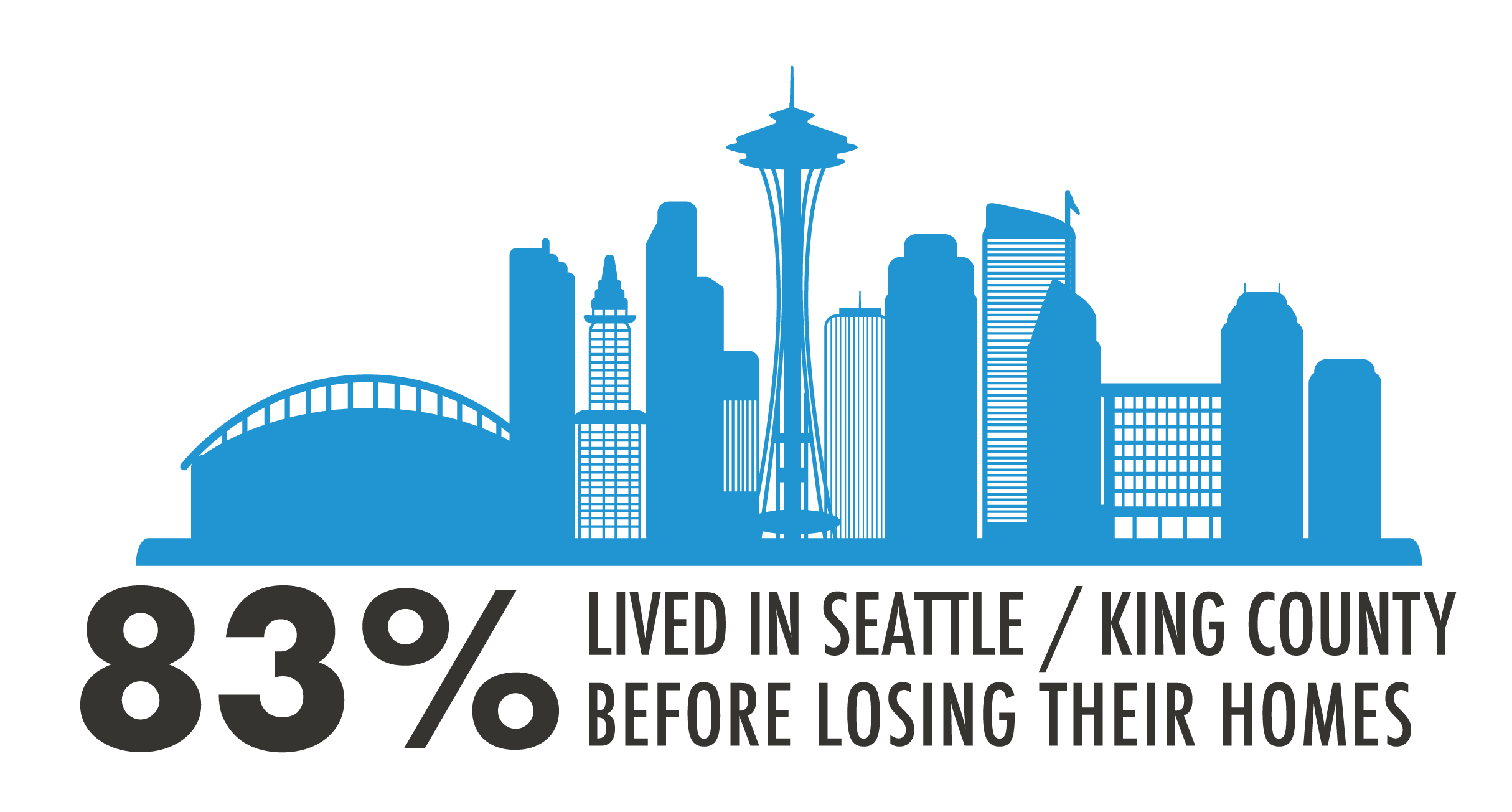
A 2018 survey of people experiencing homelessness in the City of Seattle/King County showed:
- Approximately 83% were living locally when they lost housing.
- 11% lived in another Washington county before a loss of housing.
- 6% were residing out of state.
A 2017 survey showed similar results:
- 77% of respondents reported living in Seattle/King County before losing their housing.
- Approximately 15% were living in another Washington county.
- 9% were living out of state.
Los Angeles, CA
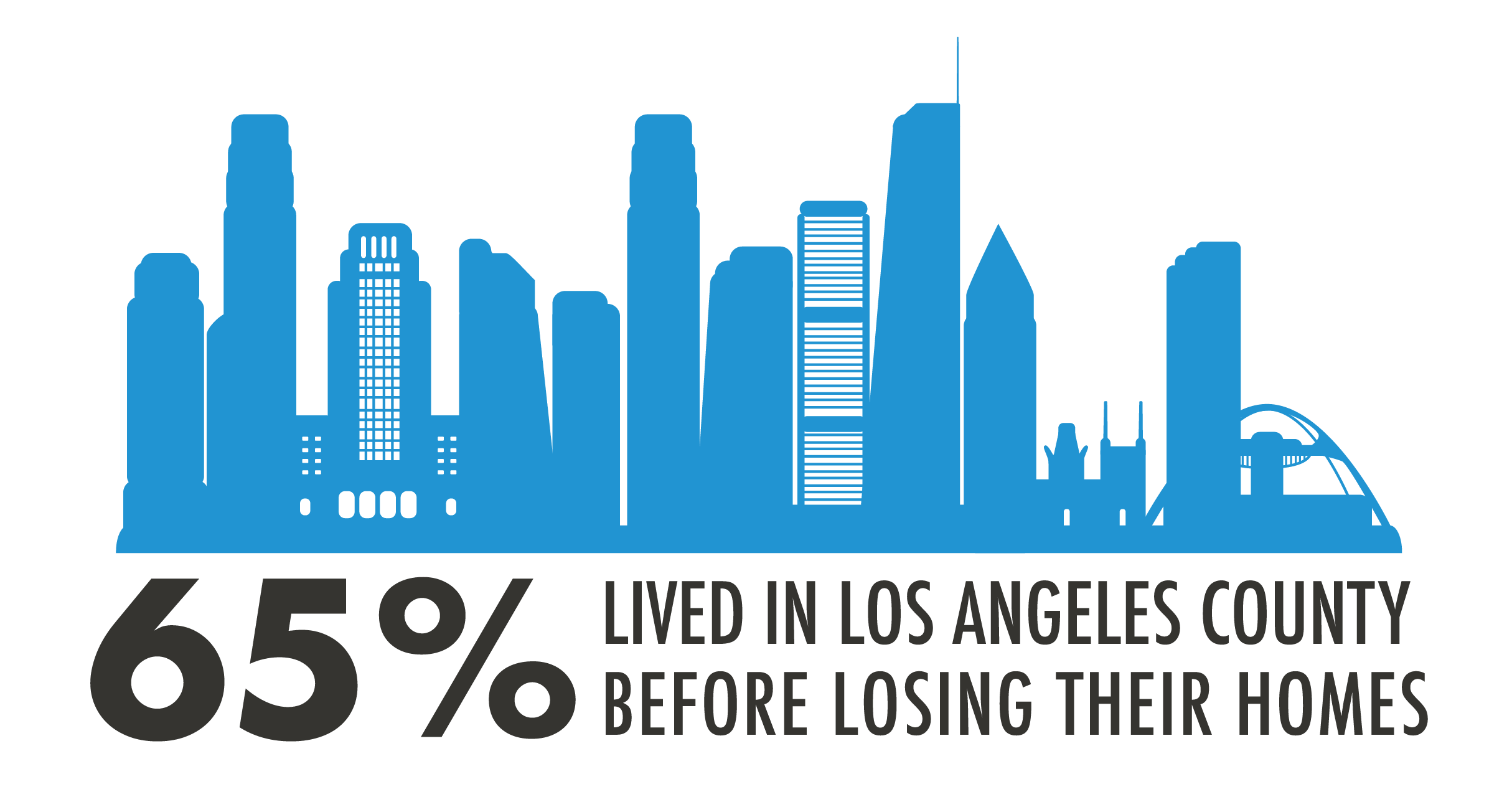
A 2019 homeless count among unsheltered adults and children in adult families living in the Greater Los Angeles area showed:
- 64.9% lived in Los Angeles County when they lost housing.
- 15.1% lived in another California county.
- 18.8% lived out of state.
San Francisco, CA
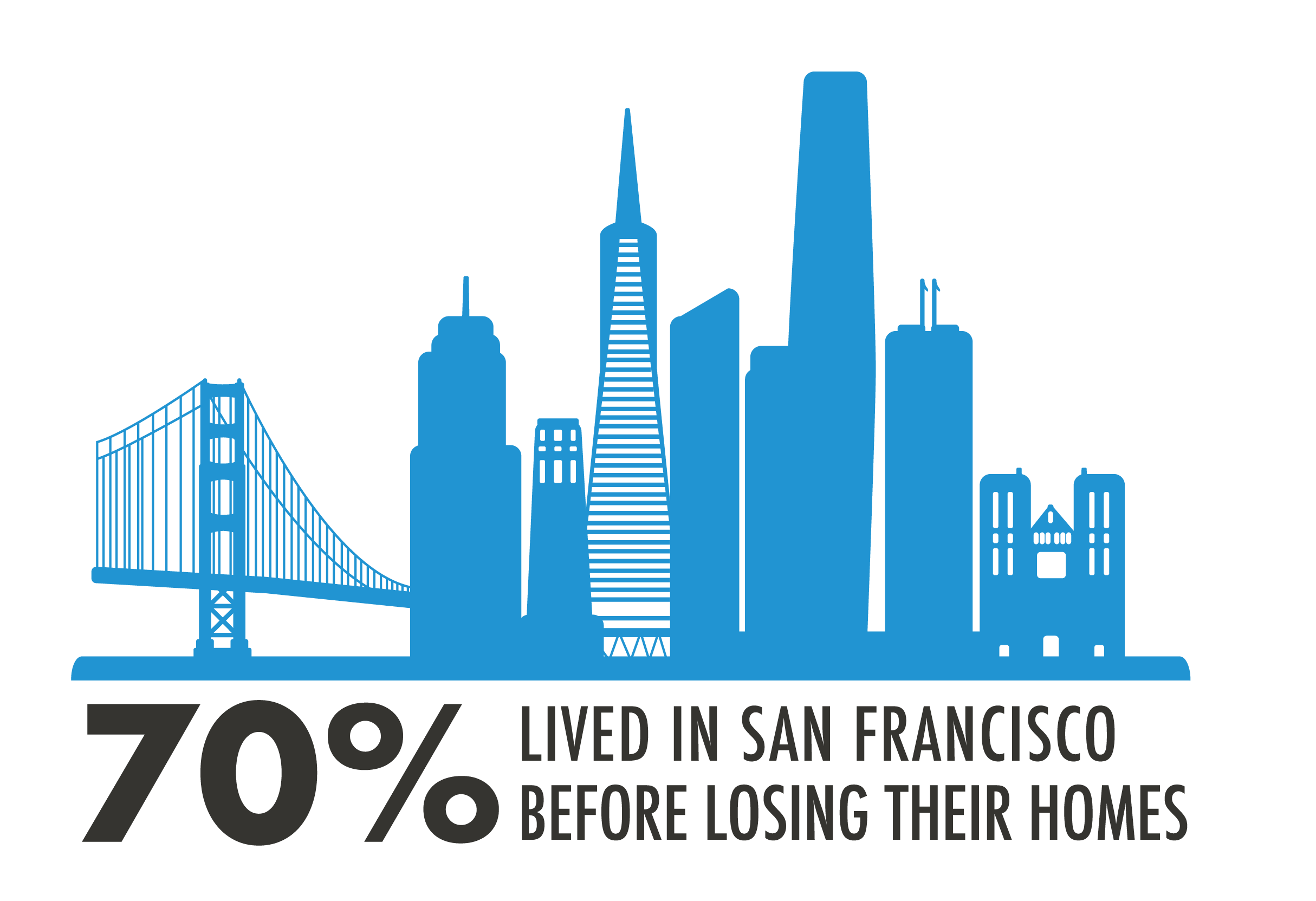
A 2019 homeless count and survey in San Francisco showed:
- 70% of respondents were living in the city when they most recently became homeless
Of the 70% who were living in the city
- 55% reported living in San Francisco for ten or more years.
- 6% said they lived in San Francisco for less than one year
A 2017 survey yielded similar findings.
- 22% reported living in another county within California.
- 8% of respondents reported living out of state at the time they became homeless.
New York, NY
Coalition for the Homeless, an advocacy and direct service organization helping homeless men, women, and children, addresses the "they are not local" myth on their website.
According to 2015 data, families entering shelters predominantly came from a few clustered zip codes in the poorest neighborhoods in New York City. The organization states families moving into shelters who previously resided outside NYC have remained a tiny fraction of the total number of families coming into shelters. They account for less than one-half of one percent of all families moving into shelters. Additionally, many families categorized as "out of town" are, in fact, native New Yorkers. The latter have lost their housing in neighboring communities such as New Jersey or Long Island.
As the statistics show, most people had not traveled to a new city while experiencing homelessness.
What’s at stake
The "they're not local" myth is just another way of saying homeless people don't belong. It’s “othering” an entire group of people. Homelessness isn't a problem brought to a community by a group of outsiders. It's born out of conditions already present, whether or not you can see people suffering. Homelessness rates rise faster in cities where residents spend more than one-third of their income on rent. In addition, a new report from the National Low Income Housing Coalition shows a full-time minimum wage worker cannot afford a one-bedroom rental in 93 percent of U.S. counties.
The most recent homelessness count from the Department of Housing and Urban Development (HUD) shows 580,466 people, or about 18 of every 10,000 people in the U.S., were unhoused. For the first time since data collection began, more people experiencing homelessness were unsheltered — meaning they stayed on the street, in abandoned buildings, or other places unfit for human habitation — than were sheltered. The coronavirus pandemic has only exacerbated the crisis.
Our unhoused neighbors are better served when we embrace compassion and reject falsehoods about who they are. Dissecting their worthiness for aid is holding them to a higher standard not imposed on those who are housed. Pallet shelter villages are “low barrier” for this reason. We value bringing everyone into a healing community with access to case management and a dignified living space so they can begin to create the life they want.
If you or someone you know is experiencing homelessness and need help. call 2-1-1 or check this list of resources from The National Alliance to End Homelessness.
This post is part of an ongoing series debunking homelessness myths.
Part Two: Homelessness is a personal failure
Part Three: Homelessness is a choice
Part Four: Homeless people are lazy

Elevating the voices of people with lived experience with homelessness, recovery, and incarceration is integral to Pallet’s mission. In addition to telling the personal stories of our team and people living in Pallet shelter villages, we aim to raise the voices of system-impacted and marginalized persons everywhere.
We’ve partnered with Path with Art (PWA) to share personal narratives. PWA is a Seattle-based nonprofit that uses arts engagement to foster the restoration of individuals, groups, and society from the effects of trauma. The organization offers year-round arts education classes, workshops, exhibitions, and showcases to low-to-no income adults.
Aaron Hill, a longtime PWA participant, says creative writing helps him cope with past traumatic events. The following is an original poem he wrote.
Just Do What You Can
by aaronjhill
COLD
15°
shivering
nowhere to go for Thanksgiving and Christmas
HOT
108°
nothing to do on July 4th
life is LONELY
i am not a people-person
i have a hard time trusting people
libraries closed
no place to SLEEP
no place to go
“you can’t be here.”
private property
public property
who to ASK for help?
the bureaucracy is HELL
red tape and no empathy
why so little COMPASSION for people?
HARD TIMES
reminds me of Steinbeck
and The Grapes of Wrath
Great Depression
Dust Bowl
economic recessions come and go
my ancestors have been through the same
cycles, never-ending cycles
haves and have-nots
does it ever end?
life can be BRUTAL
i remember that just a SMILE from strangers would LIFT me up
do what you can
to HELP
once i needed shoes for the WINTER
i put up a request on Craigslist
a young woman responded
we met at the Bellevue library
she and her husband had bought me
brand-new, waterproof BOOTS
fit me perfectly
also handed me a gift card for pizza
SHOCKED
i was so surprised
their care for a homeless man
helped RESTORE my FAITH in HUMANITY
do not forget that YOU can do that too
just DO what you can
Q&A with Aaron
Pallet: How long have you been taking Path With Art classes?
Aaron: A long time. I have tried to remember my first class. It may have been printmaking, which I love. Being able to create at the Frye Art Museum is such a joy. I love that space. It has been eight or nine years, I think.
Pallet: What's been your favorite class?
Aaron: Anything to do with printmaking or clay. I love the other classes as well. I have taken so many and learned so much, from watercolors to ceramics. It is therapeutic to get my hands into clay and start creating something. I like to work organically, seeing what comes out of my crazy head and how the medium works. Becoming friends with the teaching artists and creative mentors is an added bonus.
Pallet: How long have you been writing poetry?
Aaron: I have been writing poetry since elementary school. One teacher loved haikus, so I wrote a lot of those. I learned of E.E. Cummings and I immediately became a fan. Later, in high school, I started reading Edgar Allan Poe and became addicted to his short stories. My teachers earn a lot of the credit. They drilled us in writing.
Pallet: How long did you experience homelessness?
Aaron: One day I was trying to calculate just how long I have lived on the streets. I came up with a collective ten years. It is something like that. The first episode was so traumatic for me, a middle class kid who never dreamed that such a nightmare could happen, that I cannot remember key details. My mind has blocked it out. I was sent back home to live with my parents and felt like such a failure.
Pallet: What have been the benefits of writing about your experiences?
Aaron: Writing helps me cope with past traumatic events. Also, it is a place where you can dream. You can create anything. You can play around and experiment. It may not work, but then you try to figure out how to change that. “How can I make this work?” I want to write at least one book. Of course, it takes discipline, which I lack at the moment. But once I get going, it is hard to stop. One of my short stories for a college class developed into a novel, which got lost along the way. I lost most of my belongings and have had to start over a few times. Having mental breakdowns result in a lot of repercussions.
If you or someone you know is experiencing homelessness and need help. call 2-1-1 or check this list of resources from The National Alliance to End Homelessness.
RELATED POSTS:
Profile: Chris Hernandez, Chandler Street Tiny Home Village case manager
Community check in: Riverside, California
What’s in a name? How we chose Pallet
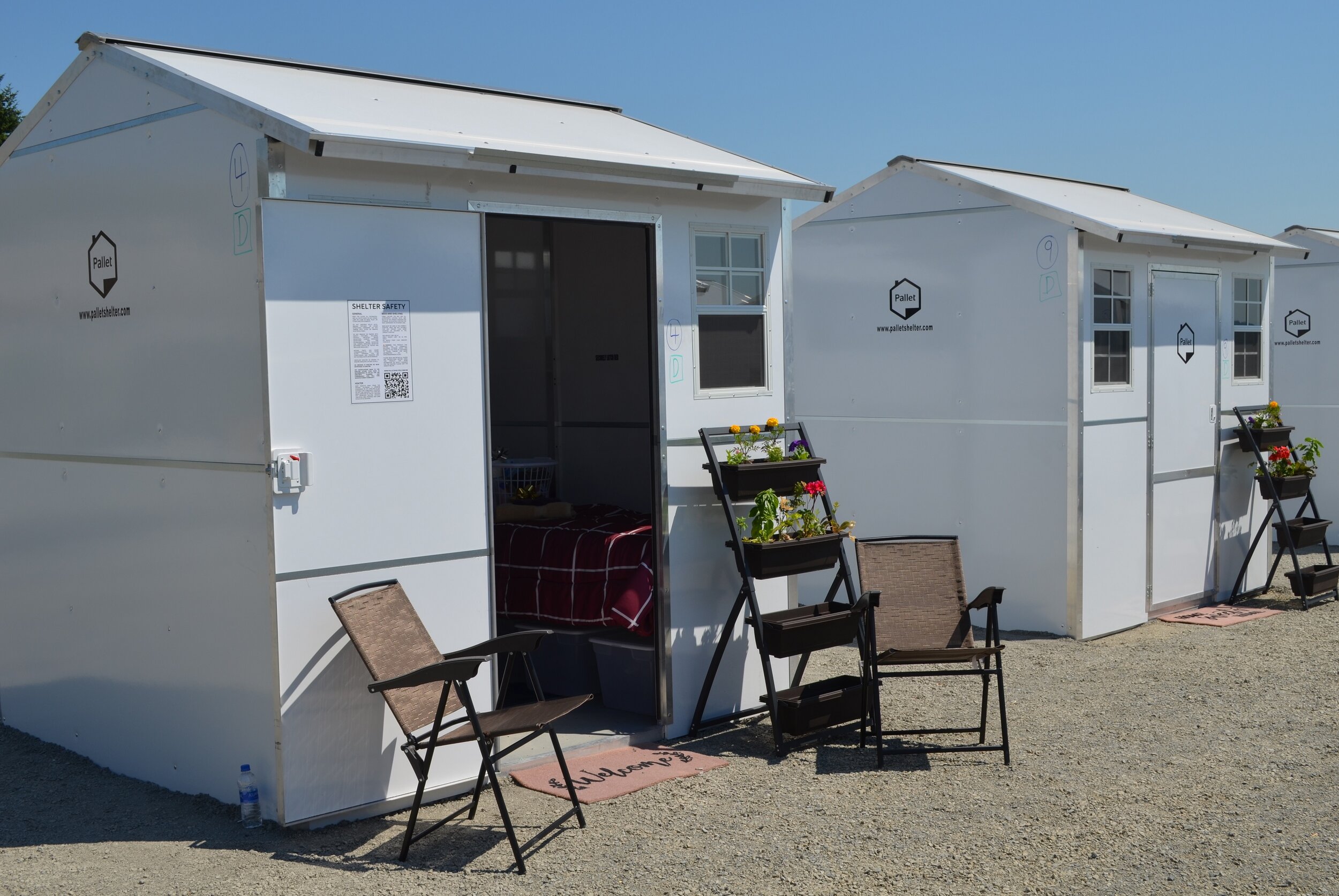
Everett’s Pallet shelter village is located behind Everett Gospel Mission, a nonprofit providing on-site services.
City of Everett Mayor Cassie Franklin is thrilled a new Pallet shelter village is available to people experiencing homelessness. She's hopeful the new low-barrier shelter option will help people who have been averse to accepting services in the past. Unhoused people can transition out of survival mode and onto the path of stability.
"The only way you can get safe and recover from the traumas of life on the street is to get inside and get that little bit of stability," Franklin said. "That's what this program is going to offer, is folks the dignity of four walls, a roof over their head and a place to put their things, to rest."
Twenty 64 square foot Pallet shelters are located behind Everett Gospel Mission (EGM), a nonprofit organization providing shelter and comprehensive recovery programs. Three of the shelters are ADA accessible. EGM is the on-site service provider for the village, and will provide residents with personalized case management. Each shelter includes beds with storage underneath, personal climate control, and electrical outlets to power personal devices. Lockable doors offer a secure, safe environment. Bathrooms and outdoor community space are available. Residents have access to showers, a laundry room, and a cafeteria inside EGM's building.
The cabins were first offered to people living on the street in the surrounding area. Many of them are couples who wouldn't be able to stay together at a congregate shelter, segregated by gender. Sylvia Anderson, CEO of Everett Gospel Mission, is eager to provide a healing community where people can create a new life for themselves.
"We're trying to fill all the gaps so that people can come in where they are and then move to where they want to be," Anderson added.
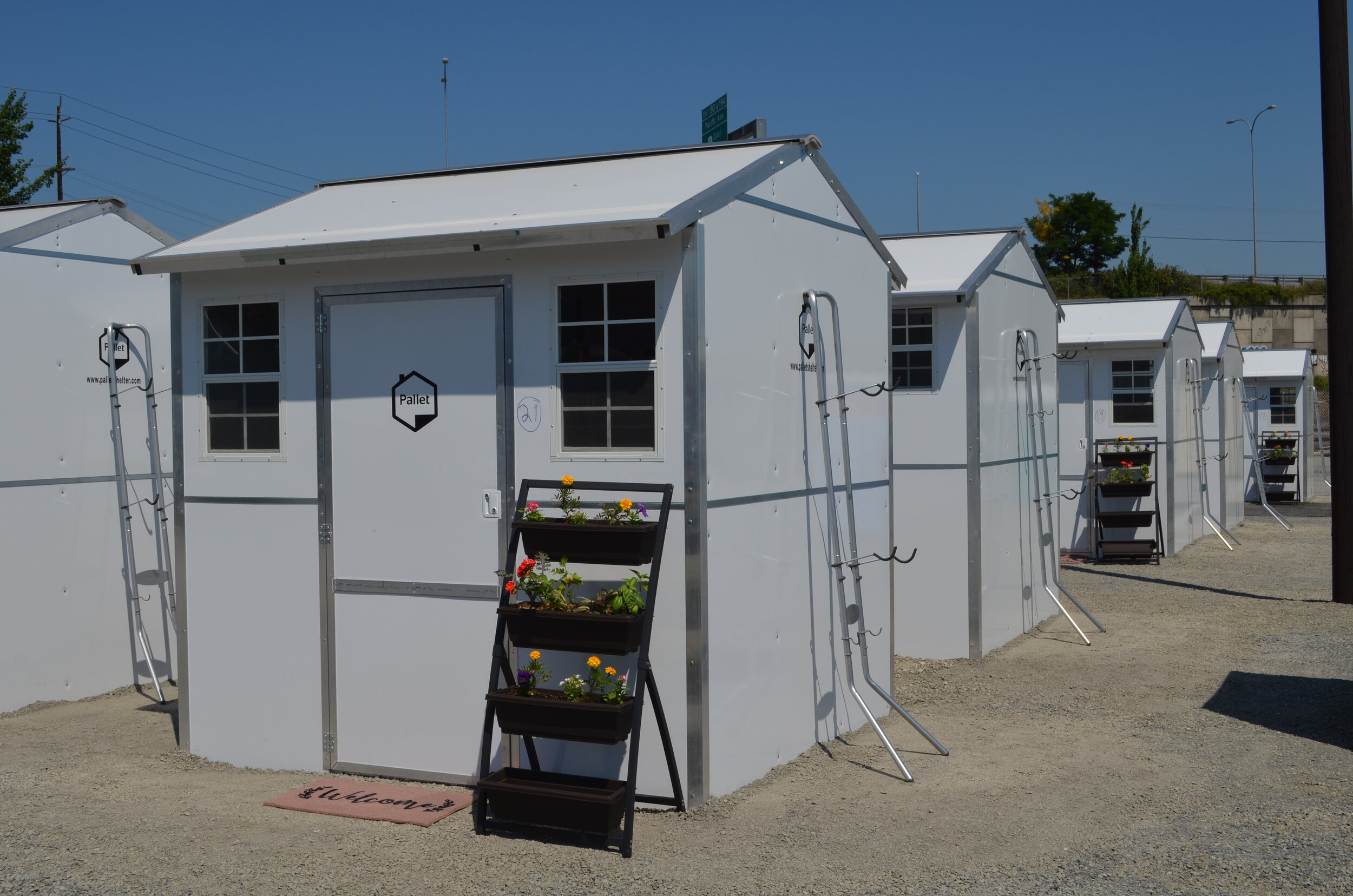
In preparation for the site's opening, Anderson consulted with service providers at Pallet shelter villages across the nation. EGM hired a case manager and a part-time mental health counselor to work with the residents. The Pallet shelter village has enabled the nonprofit to utilize a harm reduction model. There are fewer strict rules to follow while one gets help.
"It's a very different model than what we've done before, but it's a necessary model and a continuum of care for people experiencing homelessness that we haven't participated in," Anderson said. We've been eager to do that."

After opening, Everett Gospel Mission decided to spruce up the look of the shelters with scenes from the Pacific Northwest. They hired a local company to complete the vinyl wrapping.
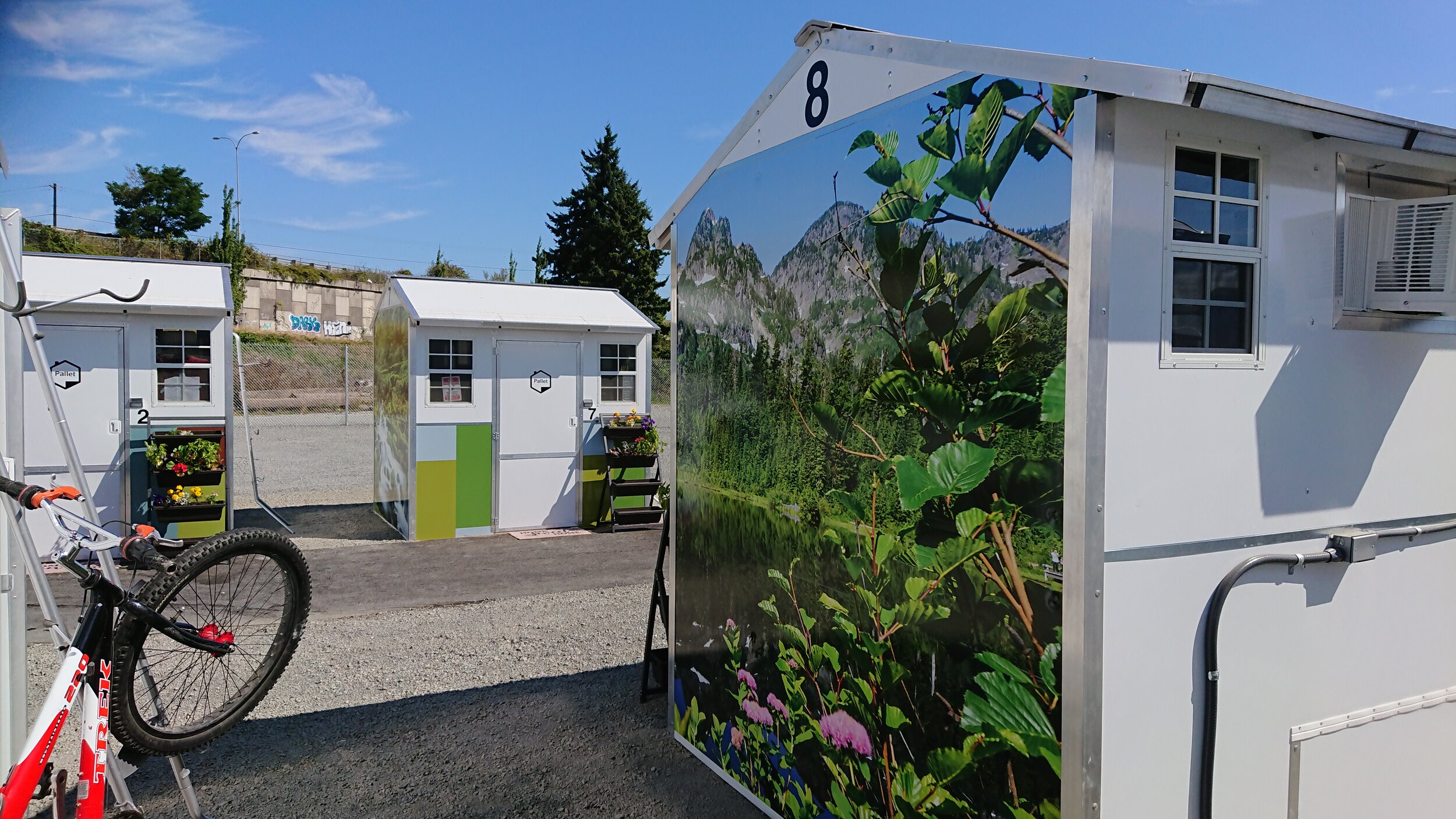
After opening, Everett Gospel Mission decided to spruce up the look of the shelters with scenes from the Pacific Northwest. They hired a local company to complete the vinyl wrapping.
Collaboration is essential in bringing a Pallet shelter village to life. At the Everett site, Pallet partnered with Construction for Change (CFC) to assemble the shelters. CFC is a Seattle-based nonprofit construction company building a sustainable infrastructure for other nonprofits across the world. The 20 volunteers who participated in the construction of this village were representatives from CFC, PCI Construction, Holmberg Mechanical, and McKinstry. Within hours the site went from a vacant gravel lot to a healing community for people living on the margins.
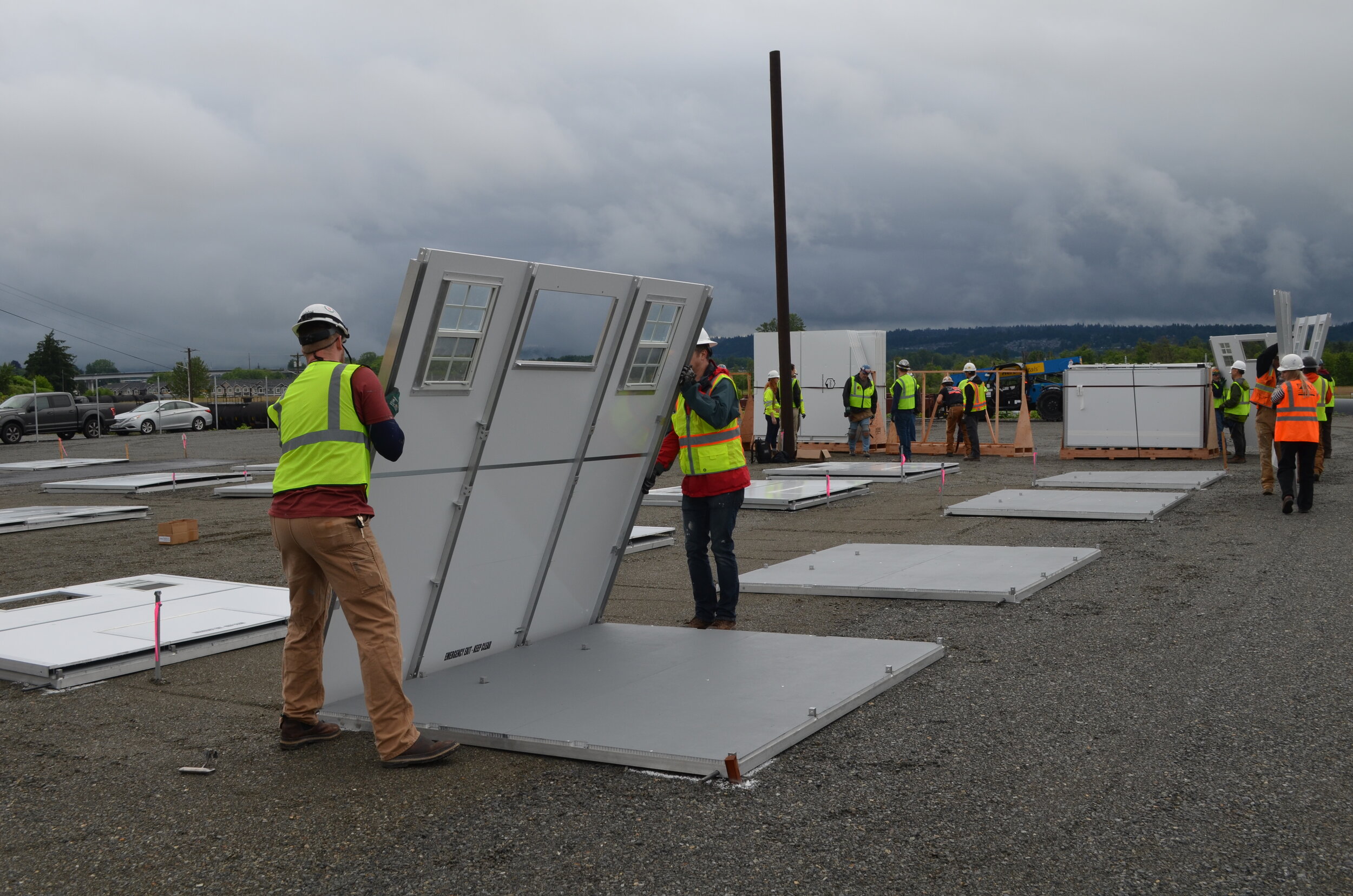
Construction for Change volunteers assemble Pallet shelters.
"It is central to the mission of Construction for Change to serve underrepresented and under-resourced communities and provide services that improve infrastructure in health care, education, and housing," said Dean Kato, CFC Director of Strategic Relationships. "It is our pleasure and honor to work alongside Pallet and improve community housing resources."
Snohomish County and the Washington State Department of Commerce provided grant funding for the site.
The priority for EGM is to get residents settled in before moving people to the next stage of permanent housing.
RELATED POSTS:
We are All Here: A poem on living without a home
Community check in: Riverside, California
New Pallet shelter village opens in Burlington, Washington
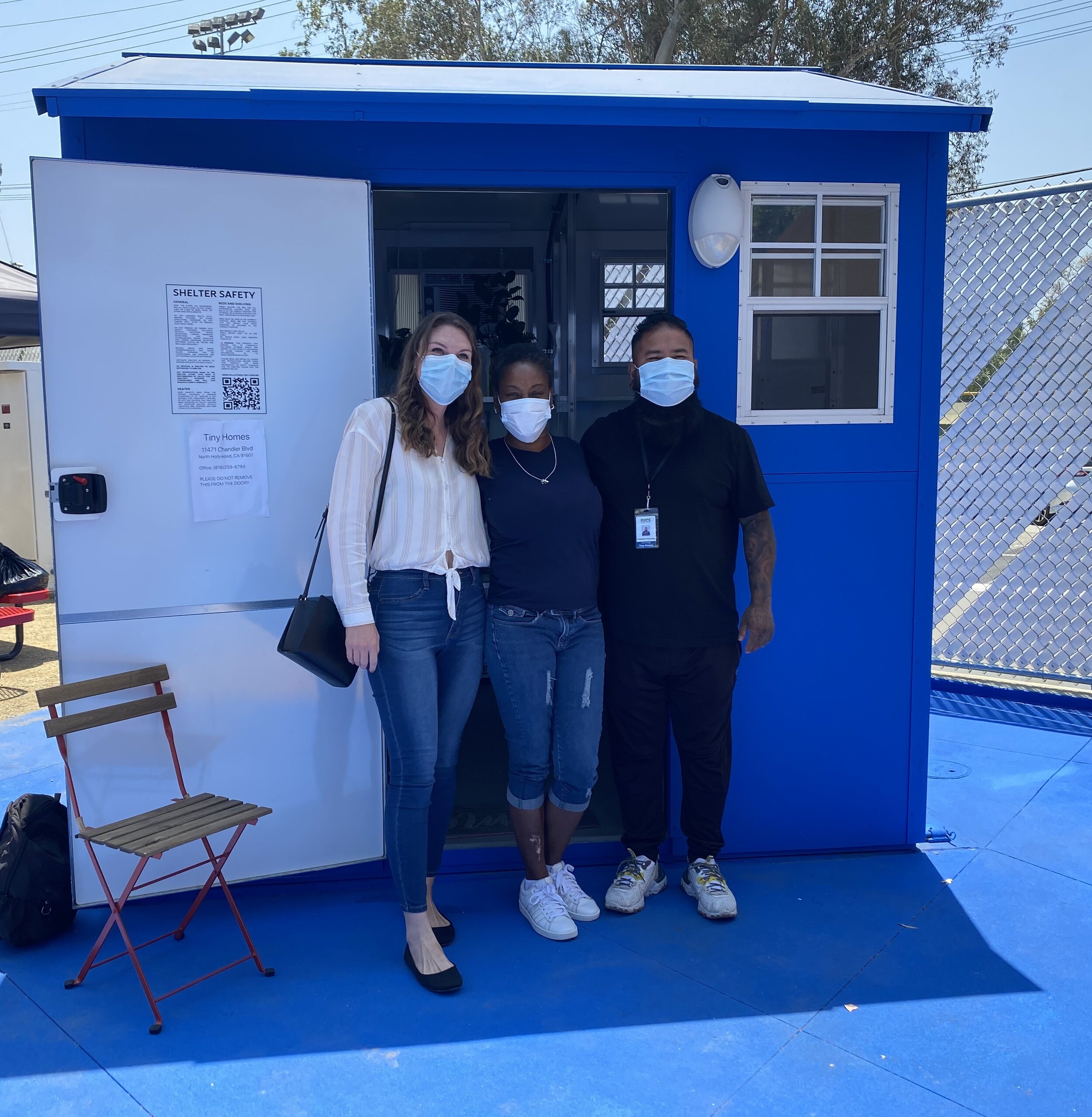
Hope of the Valley case manager Chris Hernandez (right) poses with Cindy (center), and Nicole, (left) a housing navigator. In May Cindy moved out of a Pallet shelter at Chandler Village and into a permanent home. Photo courtesy Hope of the Valley Rescue Mission.
Chris Hernandez freely admits he likes to talk. He puts people at ease and effortlessly connects with others. It's a crucial skill in his role as one of two Hope of the Valley Rescue Mission case managers at Chandler Blvd. Tiny Home Village in Los Angeles, California.
"As a young kid, I was always very verbal with people. I was always near people," Chris said. "I've worked in hospice. I've worked with quadriplegic, paraplegic people. I've worked with people with cancer. I was a nursing assistant. I worked in a nursing home. I just love being around people and helping people. And I think I'm good at it."
Chris is part of the staff who provide social services at Chandler Village, a transitional housing community made up of 40 Pallet shelters. A safe place to sleep with a locking door and on-site case management is an essential component to Pallet shelter villages, which are designed to be a stepping stone into permanent housing.
Someone experiencing homelessness on the streets would typically have regular appointments with their case manager at an office. This location may be far away from where they live. But at Chandler Village, Chris is just a few steps away.
Day in and day out, people living at Chandler Village see Chris. He builds trust with them at their pace. His constant presence reassures folks that he's not going anywhere.
"When somebody comes in, I'll just say, how are you doing? I'll be your case manager. Is there anything that you need right now? Is there anything I can help you with? We're actually serving breakfast or lunch. Would you be interested in any of that?," Chris explained. "Honestly, it just comes natural to talk to these guys. You can tell a lot of them were hesitant at first. Even the smallest things, it brightens up their day."

Chandler Blvd. Tiny Home Village in Los Angeles, California. Photo courtesy Hope of the Valley Rescue Mission
Chris is there to listen and guide residents through the steps they need to rebuild their lives. One of the first tasks is to help them secure documentation such as a birth certificate or social security card. Chris recounts helping someone get a new Electronic Benefits Transfer (EBT) card after their previous card was stolen several months before moving into Chandler Village. The card allows people to access Supplemental Nutrition Assistance Program (SNAP) benefits to buy food.
"For us, it's simple. For them, it's their life. He was a little hesitant with me. We started talking daily. I helped him get his card. They actually sent the replacement card," Chris said. "I sat with him. We called to see his balance. It was over $800. And he was so, so happy with just that one card. For him, it was just everything in the world."
Residents at the village are also connected with a housing navigator and mental health services if needed. They can apply for benefits such as Medi-Cal, no-cost, or low-cost health insurance. Navigating the various systems can be complex so having a guiding hand is helpful.
Life at Chandler Village isn't all about working towards the next step. Finding joy is also vital. Residents play games, celebrate holidays, and recently assisted artist Sara Rose with a mural. She designed it for the site in partnership with Muralism, a nonprofit organization dedicated to showing how people with special needs can do productive, valued and beautiful work in their communities. Chris says many people staying there already knew one another from living in the same area on the street, so the new location is an extension of relationships already built.

Mural at Chandler Blvd. Tiny Home Village. Photo courtesy Chris Hernandez
Before working at Chandler Village, Chris was an intake coordinator at a substance use treatment facility. He describes the work he's doing now as amazing. He began working there when it opened in February 2021. He’s invested in folks moving onto permanent housing and a few have. He’s just as excited as the resident when everything comes together, “it’s the best feeling in the world.”
Chris is happy to be a part of a solution to the growing homelessness crisis. He wants the community to have faith in the work they're doing. As much as he's helped others, he's also learning.
"Never judge anybody by who they are and how they live because that could be me one day," Chris said. "I've just learned how to appreciate the little things. Even a toothbrush, or having a place to go to the bathroom, or even a roof over my head, a lot of these guys, they didn't have that. Cause they lived in tents. And a lot of stories these guys would tell us, it breaks my heart. So, I do appreciate everything that I do have."
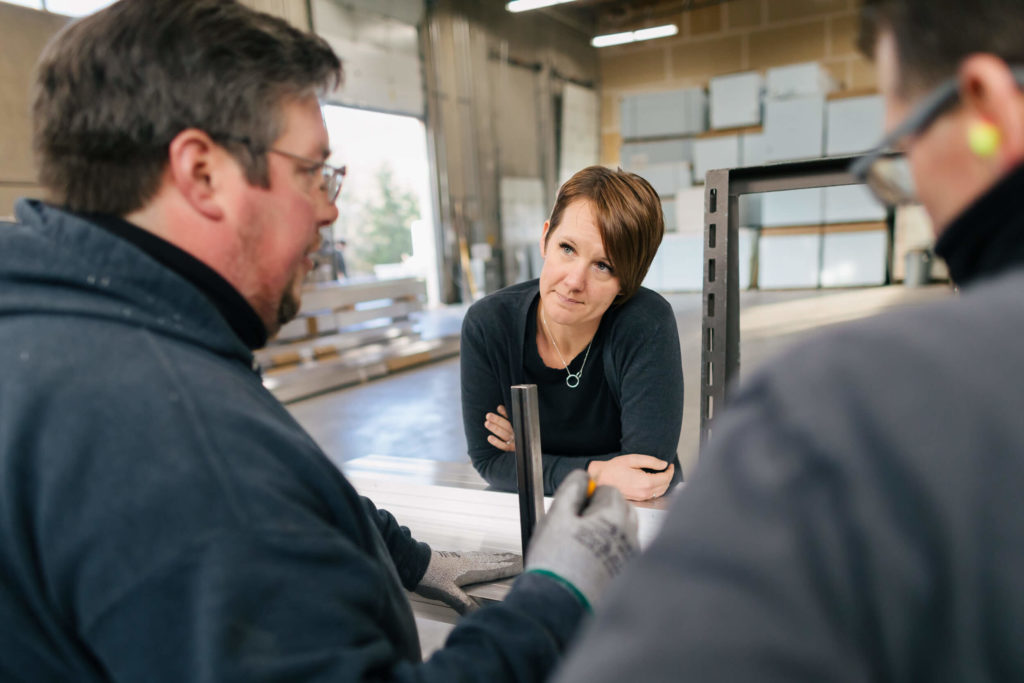
Amy King is known for her work with Pallet, a social purpose company working to end unsheltered homelessness and give people a second chance at employment. But it isn’t the only company she’s involved in. There’s also Square Peg Development, a general contractor, and Weld, a nonprofit equipping system-impacted people with housing, employment, and other resources. The three companies are similar in mission and vision, with Amy and her husband Brady as the driving force.
Recently Together Washington Executive Director Tim Gaydos interviewed Amy for the “Common Good” podcast. Together Washington is a nonprofit organization encouraging innovation and prosperity for all. In the hour-long interview, Amy discussed building transitional shelter villages, Pallet’s employment model, how Weld supports the community, and more.
Listen to the full interview here. The following is a condensed version of their conversation.
Tim Gaydos: We are telling the inspiring stories of those building the common good across our region, across our state. We're at a time where it can be difficult to be able to find that common ground, to find the places and spaces that we can build together. And so often it's hard I think in today's society, folks think that we can't hold on to convictions or values and still work with people who are different. Amy King is with us today. Thanks for taking some time to be with us, but give us that quick cursory view of what these three orgs are doing right now.
Amy King: My husband and I started a Square Peg construction in 2014 and Square Peg is a general contractor that builds permanent products, both market rate and affordable around the city of Seattle and the Puget Sound area. What's unique about Square Peg is that 83 percent of our employees are individuals that are exiting the criminal justice system, addiction recovery programs and homelessness across the city. And these are individuals that are interested in the construction trades. So our goal there is to build and develop a workforce to help us construct the amount of housing that we so desperately need of permanent housing, but also to increase housing supply so that's Square Peg’s goals.
Along the way in 2016, we started a company called Pallet, which is a manufacturing company. We design and produce rapid deployment shelters that go up in 30 to 60 minutes that are used for homelessness response, disaster response and mobile workforce housing. Those also provide job opportunities for people that are traditionally marginalized but in the manufacturing industry and same thing, more than 80 percent of the employees in that entity come from those three backgrounds.
And then along the way, we felt like, as we worked with our employees to learn more about the reentry process and reintegration following homelessness and addiction, we realized that people need a lot more than just jobs, although that is a really key piece of their success in reintegration. And they needed things like housing and wraparound resources and connection to public services and community groups. And so we started a nonprofit called Weld Seattle. Weld Seattle houses about 150 people a year using vacant developer properties across the city. And then we also have an employment program in that entity. And we're really excited to announce that next year we're opening Seattle's first ever Collaborative Reentry Resource Center through that entity as well. So lots of fun stuff going on. We're really excited about it.
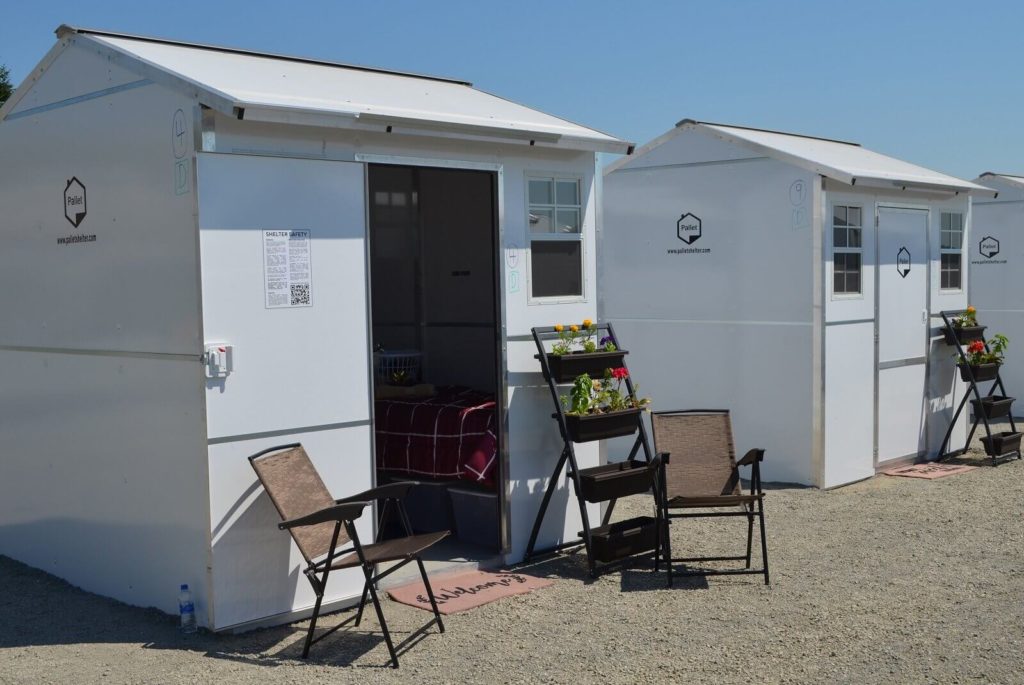
Tim: Wow. I mean, amazing work. Congratulations. So great. And I mean, I've got 30 follow up questions from all that.
Amy: Great! (laughs)
Tim: First, on Pallet. Some folks might — they're hearing a lot about tiny homes or tiny houses. Because so many folks here in the region, over the last few years it's been in the news every day. Homelessness and what's happening. And they're hearing a lot about tiny, tiny houses. Is that what you're doing?
Amy: Yeah, kind of. When you think of the tiny homes, people have different views of what a tiny home is. So what we provide are emergency shelters that are individual in nature. These are singular or double occupancy units. They're a little different from the tiny homes that you see around the Seattle area today in that they're made of a nontraditional construction material. So they're cleanable, sterilizable, they’re panelized. They go together fast. They can be moved really easily and taken apart if needed. They're really meant to be more of a functional, urgent response. We see homelessness as a crisis that should be treated like an emergency. So we created something that was scalable and rapid-use and easy to use and reusable so that we could start acting like homelessness is the emergency that it is and we could get people into housing as quickly as possible. All of our sites across the country are set up in a community setting. Units are set up around hygiene facilities, food services and all of our sites — it is a requirement for us — all of our sites have full-time, around-the-clock service provision, case management and rehabilitative efforts for the residents who live there.
Tim: Wow. So you're doing this, I know in Los Angeles. Are you doing some of this in Seattle? Or I know there's been maybe some movement to do some work here in Seattle around the tiny houses.
Amy: Yeah, there's been a lot of talk in the Seattle area around this movement and expanding tiny home villages. We to date have set up one unit in the Seattle area, excuse me, one site. And that was in connection with King County and Dow’s team [King County Executive Dow Constantine]. It's down on Elliott Avenue. Last year, we set up just over 2,000 shelter beds across the country, everywhere but our own backyard, which is, you know, a bummer but we get it. It's all right. So we do have sites — our longest running site, actually is in Tacoma close by. And it's a fantastic site with an 89 percent success rate, placing people in permanent housing. So we're really proud of that site.
Tim: Tell us about the work down in L.A., because you're down in L.A. quite a bunch.
Amy: Yes. So we've been working with elected officials in L.A. at the city there for just over a year. As you're probably aware, there are 66,000 homeless people in L.A. and 48,000 of those are unsheltered. So really just a massive problem. And so they are working with a number of groups to do a broad based approach and response effort to get as many people inside as quickly as possible. As you might be aware, there's also a federal Supreme Court case going on there where the L.A. Alliance for Human Rights sued the city and the county for their lack of response over the last 10 plus years. And so their urgency is being somewhat fueled and motivated by that. But actually, the city has actually really stepped up and has been great to work with and is starting to move with urgency and think creatively and embrace innovation when they think about responding to homelessness there.
Tim: Is that going to be a long-term relationship for you guys down in L.A.?
Amy: I hope so. I think so. It kind of depends. There's a lot to it that has to be considered in terms of service provision and all of that and site selection. And so I think they'll be ongoing opportunities for us to set up additional sites and rehabilitative communities for people there. One thing that we are looking at, because there's been such a broad-based response there. They're really interested in our social impact employment model that we have here, where we're employing people that need jobs. And so we are looking at a coordinated effort with them right now to put a secondary production plant on Skid Row. They are working hard to move people off of Skid Row as quickly as possible into housing, not criminalizing for homelessness, not sweeps, but to move people into effective housing with services. And part of that is job creation. So we are hopeful that we might be a part of creating some jobs for people as they exit that system down there.
Tim: That's wonderful. That's a great just a little segue to talk a little bit about what's happening here and just get your thoughts, overall kind of assessment of how we're doing here. Where are challenge areas? What can we be doing better when it comes to folks here without homes?
Amy: That's a tough, loaded question. But I'll be honest. I think what we see across the country — as I mentioned, working with L.A. and with a number of other cities across the country — what we're seeing is this really awesome creative approach to think about new ways of responding that address the root cause issue. And then sometimes we go to cities where we see this obsession with the status quo and permanent housing is the only way. As a side note, permanent housing is needed. It's absolutely the way. But we [Square Peg] also build permanent buildings. So we understand how long it takes, how cost prohibitive it is. And we cannot allow our streets to be waiting rooms for permanent housing. And that's the approach we've taken in L.A. and everywhere. And I would say it here as well. What I see when I drive around city of Seattle is we have allowed our streets to become waiting rooms for people who need our help. They are suffering and they need a place to go. They need a place to stabilize and to engage with services.
Tim: One of the things I wanted to ask you about Amy, I really want to hone in on is, you said 83 percent of your employees have come out of the criminal justice system or have experienced homelessness, addiction. This is powerful. How did that start? Where did that come from? And how is that going?
Amy: We started this work very much by accident. It sort of happened to us more than we sought it out. But now we very intentionally seek it out. And it is kind of the core of our mission here across our companies. When we first started Square Peg in 2014, my husband had set out to hire some laborers to help him. And we posted the job on Craigslist, Indeed, all the different various places that you post and literally nobody applied. And at the time, there was just this massive shortage of construction workers. There still are, it's improved some. But, at the same time, we had a mutual friend who came and asked us to help and coordinate with another gentleman who had started his own construction company and had five employees working for him. He said, could you teach him what you know about the business side of running your own business and kind of work with them? And so we were contracting them as laborers and I was helping them build out their business aspects and kind of talking through some of that with them. And then finally, they came to us and said, you know, to be honest with you, we started this business out of necessity, but we would rather just work for you guys. And we said, well, that's great. That solves the problem for both of us. So we sort of absorbed them into what we were doing.
And then — as is my practice as a manager, which I've been managing people my whole career — I went and intentionally sat down with each one of them and said, you know, tell me your story and where do you come from and how can we help you grow and all that kind of stuff. Not knowing at the time that all of them had this pretty extensive criminal history, and so when they told me where they had come from and that they were all engaged in reentry following release from incarceration, I was like, oh, my gosh, this is crazy. I grew up in Edmonds [Washington], very sheltered. I had no experience with this stuff. And in my initial reaction was fear because I didn't know. And I thought, oh, maybe I should be scared of these guys. But at the same time, I had already gotten to know them for a period of time. They had been working alongside my husband. They were amazing employees, like very hard workers, very conscientious, just really trying to prove themselves and doing a fantastic job. And so my husband and I had to sit down and say, you know, it doesn't matter that they have a criminal history, we're doing construction. It's not like we're working with small children or we're doing something that a background check would disqualify them from. We came back to it and said, well, maybe it's worthwhile. Let’s just see how this goes.
I've managed hundreds of people in my career in this industry and in health care. And I have never had such enthusiastic, conscientious workers as the people that we hire. They are the most phenomenal employees. And the rest of the employment world is totally missing this talent pool.
They work hard. They prove themselves. They're constantly trying to learn and grow and create a better opportunity for themselves. And many of them acknowledge the fact that they haven't always made the best choices. Often those choices are driven by frustrating circumstances that are outside of their control or response to trauma situations, things that are understandable to me now that I know and understand so much more about how they ended up where they did.
Tim: Absolutely incredible. That's just something, as you said, that is overlooked. Not only did you see this hiring pool, but you also saw the fact that as you got in, you start to hear their story. And how much story matters. The fact that second and often third chances are important. Tell us about that. I know there's so many stories you could probably tell about this, but what's something that sticks out?
Amy: I have so many stories, but just as a blanket, I can very confidently say that 100 percent of our people that we work with and for, a hundred percent of them have a significant childhood trauma. One hundred percent. And that is the common denominator. They've had some trauma that's happened to them. That was not their doing. And yeah, maybe they made some bad choices in response to that trauma. But, you know, it's interesting, you use the word second chance, and that's a common terminology that we hear, third chances. What I would argue is a lot of our people never had a chance to begin with. They grew up in poverty with parents that were not engaged or couldn't engage because of their own past circumstance. They did not have access to good education, to good nutrition, to housing. They did not have access to the same opportunities that I had growing up in a privileged environment. And all of them, when they tell me their stories and I hear what they've come from, I'm like, dear God, if I had gone through what you went through, I don't think I would be upright. How are you functioning in society and carrying on? And I think that's the part that I walk away from my job every day going, it's easy for those of us with opportunity and privilege to look at and judge people who are in situations different than us and say stupid stuff like pick yourself up by your bootstraps. I hate that saying, I absolutely hate it. And knowing now those people and walking alongside them in their journey, I realize that there's no bootstraps. They're not even wearing any boots. There's a totally different scenario there that I think many of us that come from privilege, if we had to journey through what they've journeyed through in terms of that childhood trauma and neglect, we would not be alive. They have navigated poverty and addiction and abuse and neglect and things that most of us would never stand up underneath. I see the people that work with us as heroes. We see people everyday, men and women, that are reunited with their children. We see families being put back together. It's a really beautiful cycle of watching people put their lives back together and then turning around and offering what they've learned back to their communities in meaningful ways.
Tim: Amy, one of the things that you have going now is Weld. The Seattle Times did a great feature on this a few months ago. Tell our listeners about what Weld is and what's coming.
Amy: Yes, so we're really excited. Weld, it is a nonprofit organization that basically provides housing access to opportunity and resources around the city for people that are reentering following incarceration, addiction, recovery and homelessness. And so we have a couple of different program areas. For the last five years now, we have been housing people, utilizing vacant developer properties throughout the city. So that's our primary program area. We turn those houses into clean and sober living houses. They are democratically run by house managers on site with accountability, with meetings, regular meetings and all kinds of services set up inside the house to help the rehabilitative process of the individual that are living there. We housed about 100 to 150 people a year in that program and it's just been wildly successful for us.
Last year we also launched a program called Weld Works, which is a staffing agency that provides individuals exiting the system to contract labor jobs. We started out in the construction industry because that's what we know. But we're now working in cleaning and sanitation and manufacturing, hospitality, all kinds of industries. And the thought there is kind of twofold. One is we want to introduce people exiting the system to jobs and we encourage employers who hire our individuals on a contract basis to pick them off if they like them. There's no placement or headhunter fee if they decide they want to employ them. And we will continue to support the individual for up to a year after placement in employment with all of their soft skills and other needs outside of employment. And then we also want to encourage employers to sort of, as I say, dip their toe in the water of second chance employment and try out the model that we love and embody and think is really meaningful. And so this is a way for them to see what would it be like to employ someone coming from that background.
The last thing which we're excited to announce is 1426. So earlier this year, we were very graciously given a building by Rich Barton, the CEO of Zillow and his wife, Sarah. They bought us a building on Jackson Street just up from Pioneer Square. And we just received our building permits, which we are so excited about. And we're going to be renovating that building and turning it into Seattle's first Collaborative Reentry Resource Center. So we will be partnering with organizations like Recovery Cafe, the Clemency Project, Innocence Project, a whole bunch of groups that are doing awesome, criminal justice and social justice work in and around the city. And we're going to be providing mental health and social work services, adult education classes, resume building, job placement, housing placement. And then we're also very excited the basement is going to have a yoga studio and art studio and a recording studio in partnership with Pearl Jam and some great art organizations in our community. And we'll be offering trauma informed creative therapy services out of the building as well. So really exciting.
We won't be open for about nine to 12 more months, but that entire effort is entirely led and driven by people with lived experience. So Weld is completely staffed with individuals exiting the system who have experience with the system all the way from our executive director down. Everybody on staff has that lived experience and they build amazing programs that are incredibly effective. So we're really excited.
Tim: Well, you had me at Pearl Jam. So they're partnering with you all. What does that look like?
Amy: They've been great to help us funding and sponsorship of the recording studio itself. And then as you're probably aware, a number of members of Pearl Jam have been engaged with all kinds of cool community service programs like MusiCares. And so we're looking at opportunities to do music-based awareness building around social justice issues and then opportunities for troubled youth that we're trying to prevent from going into the system, that kind of stuff. So there'll be a recording studio there where we can work with youth on music and we'll have pottery wheel and art and yoga and all those things. So the idea there is, you know, people are going to come into the space and do some really hard work that's really important and significant around their trauma and around their experience. And you can kind of let that out in a creative way.
Tim: Amy, what do you do in your spare time?
Amy: (laughs) I work. I don't have a lot of spare time. This is something that obviously we're very passionate about and actually 1426 kind of is my spare time passion project. I am the founder of Weld, but I have very happily handed it off to really capable people who come from the backgrounds that we serve and they really run that. And I just step in and help them as needed. I can't take credit for the beautiful programs that they have created and run today. They do beautiful, amazing work. And I would be remiss to not talk about, they actually have a less than three percent recidivism rate in the programs that they've built. The national average for five years [after release], recidivism rate across the country is 77 percent. And Weld's recidivism rate is three. It's because it's run by people who come from that background.
Tim: How do you want to be remembered, Amy?
Amy: That's a really, really good question. I would love to be remembered as a social justice warrior. As someone who fought for the people who couldn't find their own voices, and that I want to be the person who hands any microphone that I have off to someone who doesn't usually get that chance. I want to elevate the stories and voices of the heroes that I get to walk with every day. And I want to be remembered because of them.
RELATED POSTS:
Putting people before profit: Why we’re a Social Purpose Company
Community check in: Riverside, California
Pallet employee Josh thought the life he has today was out of reach

Elevating the voices of people with lived experience with homelessness, recovery, and incarceration is integral to Pallet’s mission. In addition to telling the personal stories of our team and people living in Pallet shelter villages, we aim to raise the voices of system-impacted and marginalized persons everywhere.
We’ve partnered with Path with Art (PWA) to share some personal narratives. PWA is a Seattle-based nonprofit that uses arts engagement to foster the restoration of individuals, groups, and society from the effects of trauma. The organization offers year-round arts education classes, workshops, exhibitions, and showcases to low-to-no income adults.
Pam, a longtime PWA participant, describes PWA as having a profound effect on her life. The following is an original poem by Pam.
We are All Here
We live in tent cities behind nylon walls, huddled in wool blankets in doorways of neglect.
We live in secured high-rises casting shadows below, houses flooded with desire, homes gated in fear.
We live with slumlords and in public housing too.
We live alone in our minds, wandering along pathways edged by open chains.
We work for corporate greed,
We dumpster dive for food,
We work for non-profits to build a better world,
We ask for spare change, sometimes shoot-up to heal a gaping wound.
We are honest laborers, the shrunken middle class,
We do not ask for handouts, but will reach for a helping hand.
We race upstairs chasing freedom and we lounge on city streets,
We stand in long lines at food banks, waiting for leftovers we can't afford,
We walk in parks and shop behind gilded walls.
Sometimes we steal in the night, while white collars take in the light to line their coffers gold.
Sometimes life feels darker than the backside of the moon;
we watch her catch her breath
as she rushes to soften the edges of what we call urban blight.
Sometimes we feel the ecstasy of unity, especially on nights like tonight.
We are a city on shifting tectonic plates, frayed at the edges,
clothed in attitudes of love and dismay.
We are a city of others, separate and near.
We are teachers and students alike, but webs twist around our minds, our lives,
isolating us from those who look and think more different than we'd like.
We are all here, polarized by red and blue fear.
We must break down the walls,
Step out of the shadow of Them, Other, They.
We must hold our sister's gaze, grasp our brother's hand.
Link our minds to overcome judgments about what we think is right.
We are all here; the me in them.
The drum beat of our city, the heartbeat of Seattle,
the energy that makes our diversity vibrate with rhythm that unites.
We are All here and we're not going anywhere.
Q&A with Pam
Pallet: How long have you been taking Path With Art classes?
Pam: I've been with PWA for 10 years. I can't believe it's been that long. Taking classes with them has given me so many opportunities, including giving me a voice and a platform from which to speak.
Pallet: What's been your favorite class?
Pam: Probably the class that made the biggest difference in my life was a chapbook class. They helped us publish books of our own poetry, self-published but still. I never dreamed I could do such a thing. Mostly I take writing classes, but all the classes I've taken have been incredible. Especially access [to] art events, opportunities to go to the symphony, opera, plays, performances. They help me feel like I'm part of society, and participate in things that normalize my life.
Pallet: What have been the benefits of writing about your experiences?
Pam: For most of my life creativity wasn't on my radar, then through the Recovery Café I heard about PWA. I was terrified to take a class; I didn't feel good enough and was certain they wouldn't want me. Well, I found the courage and signed up for a class and it changed my life. It has given me confidence to step out into the world in other ways, to feel worthy, like I belong.
Pallet: How long have you been writing poetry?
Pam: PWA was where I began writing poetry; it has helped me process my life/trauma in an indirect way, which in a lot of ways has been more effective than any therapy I ever had.
Pallet: How long were you without a home?
Pam: Aside from couch surfing, I experienced 'houselessness' two different times for a total of about a year. Once I lived out of my car and the other time I lived in a tent while I was waiting to be approved for housing.
RELATED POSTS:
Putting people before profit: Why we’re a Social Purpose Company
New Pallet shelter village opens in Burlington, Washington
Resume Not Required
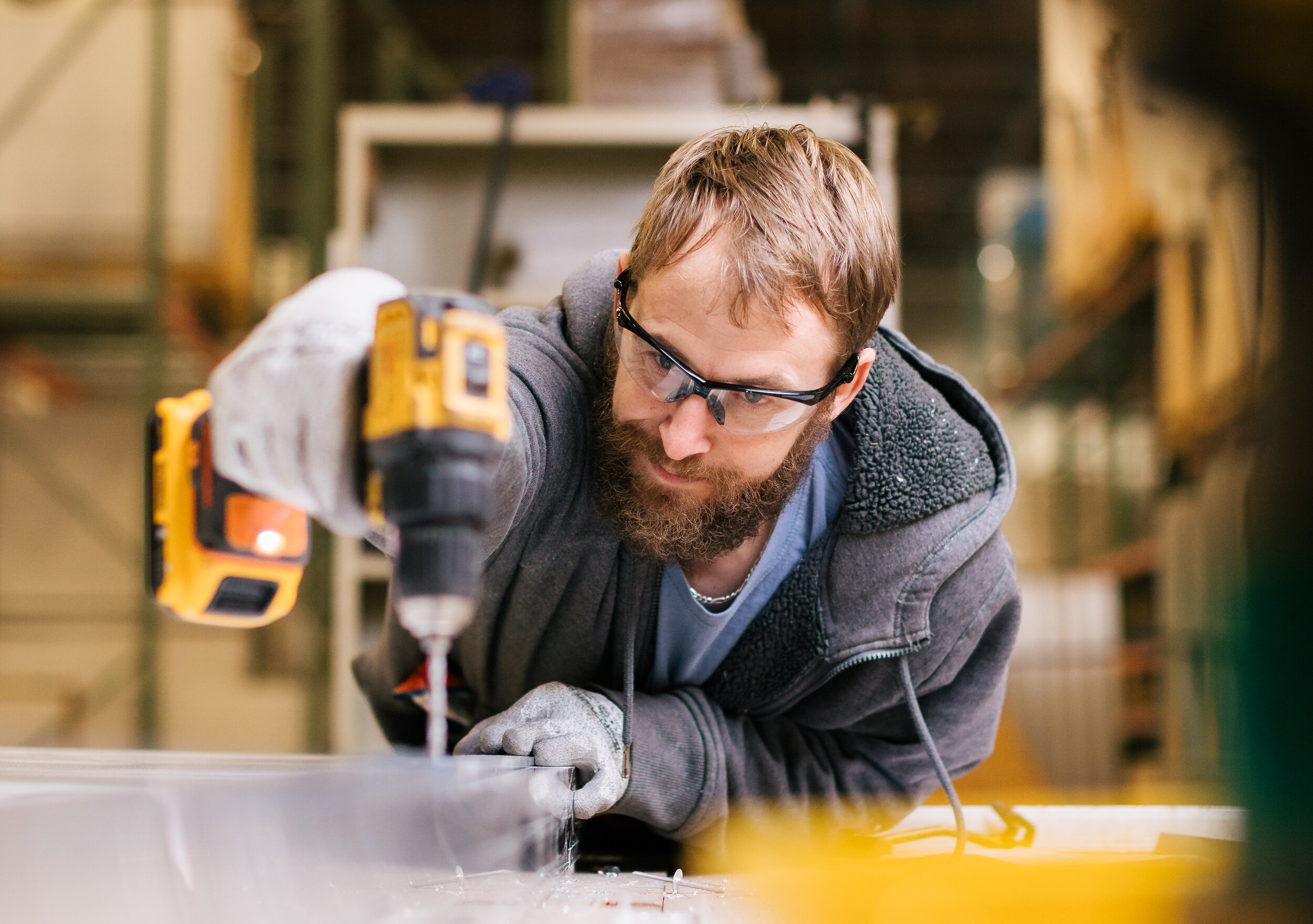
Alex is a manufacturing specialist at Pallet.
Pallet employee Alex knows firsthand why our shelter villages are a crucial lifeline for people experiencing unsheltered homelessness. For about a year, he lived in a tent in the woods with his girlfriend. There are countless challenges to living outside, and Alex is thankful those days are behind him. He's worked at Pallet as a manufacturing specialist for a year, lives in an apartment, and is in recovery.
"I just got my driver's license back. I got my car. I became a Costco member. All things two years ago I never thought I'd do. Building my credit back," Alex explained. "I have a great job. I love what I do here. I love providing shelter for people. I love the people I work with."
Alex said being homeless was a stressful and horrible time in his life. He had to stay warm, worried about other people stealing items from his tent, and tried to avoid being seen going into the woods for fear of someone reporting him to the police. On one occasion, his tent collapsed under the weight of snow while sleeping, soaking everything inside. It was a situation he described as miserable. In another incident he woke up to the tent engulfed in flames in another instance because a propane heater caught fire. Thankfully, he wasn't injured.
His substance use disorder compounded the difficulty of living outside. It was a cycle that began as a teenager and lasted for 15 years. Nevertheless, he was able to work steadily until the year before he began recovery. Alex was tired of barely surviving when he heard about the Snohomish County Diversion Center. The program is for people experiencing homelessness who have substance use disorder and other behavioral health issues. Instead of being incarcerated they have access to treatment.
“Now that I've got some clean time. Today I can easily make the choice not to do it [use substances]," Alex said. "It was a long rough road that took away every good thing I ever had. And it ended up to where it was either going to be jail, dead, or change my life. I made the right choice."
Alex has been in recovery for two years. He's also enrolled in the Therapeutic Alternatives to Prosecution (TAP) program, an alternative to prosecution for adults with substance use or mental health problems contributing to their involvement in the criminal justice system. He's completed 100 hours of community service, paid off fines, and checks in with a counselor. Once he completes the program, three pending felonies will be dismissed.
Alex applied for a job with Pallet because he needed a second chance. His criminal record didn't disqualify him, and he joins many others at the company with a similar background who now make living wages with full benefits, such as healthcare and 401k savings plans.
"Being around other people in recovery is huge. It's people that have gone through what I've gone through," Alex said. "I pray every day that I don't ever go back. My life today is so much better. The things that I go through today. The stress I go through is nowhere near — nowhere near what I used to go through."
When Alex isn't building prefabricated shelters on Pallet's factory floor, he's spending quality time with his girlfriend and children.
RELATED POSTS:
The streets can’t be a waiting room. Why Pallet is one solution to unsheltered homelessness
Pallet employee Josh thought the life he has today was out of reach
Resume Not Required
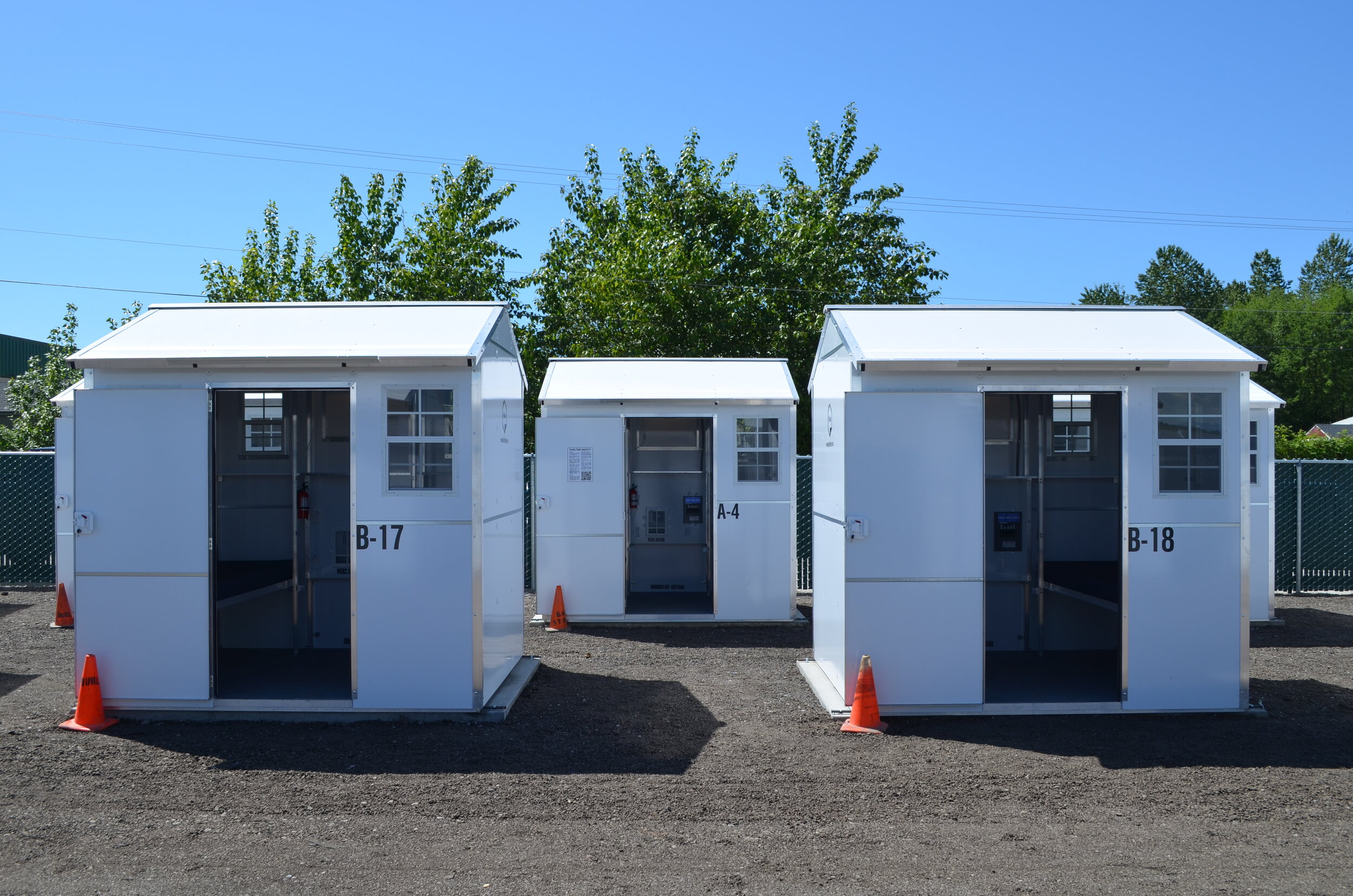
Pallet shelters in Burlington, WA.
On a warm sunny afternoon City of Burlington Mayor Steve Sexton eagerly introduced a new temporary housing resource for people experiencing homelessness. It’s called Skagit First Step Center and has 38 Pallet shelters that will serve as a low barrier option to bring people inside. A crowd of about two dozen people toured the site and got a firsthand look at where people will be staying when it opens. Three of the shelters are ADA-accessible.
Friendship House, a nonprofit organization focused on transforming a person's crisis situation into an opportunity for empowerment and self-sufficiency, will provide 24/7 site management at Skagit First Step Center’s shelter village. The goal is to get program participants stabilized then moved into permanent housing. While staying in the Pallet shelters, residents will have access to mental health and substance use support, employment services, medical visits, meals, and transportation. In addition, each shelter has a locking door, electricity, climate control, foldable beds, and more. The site also features a pilot of Pallet’s communal bathrooms and showers.
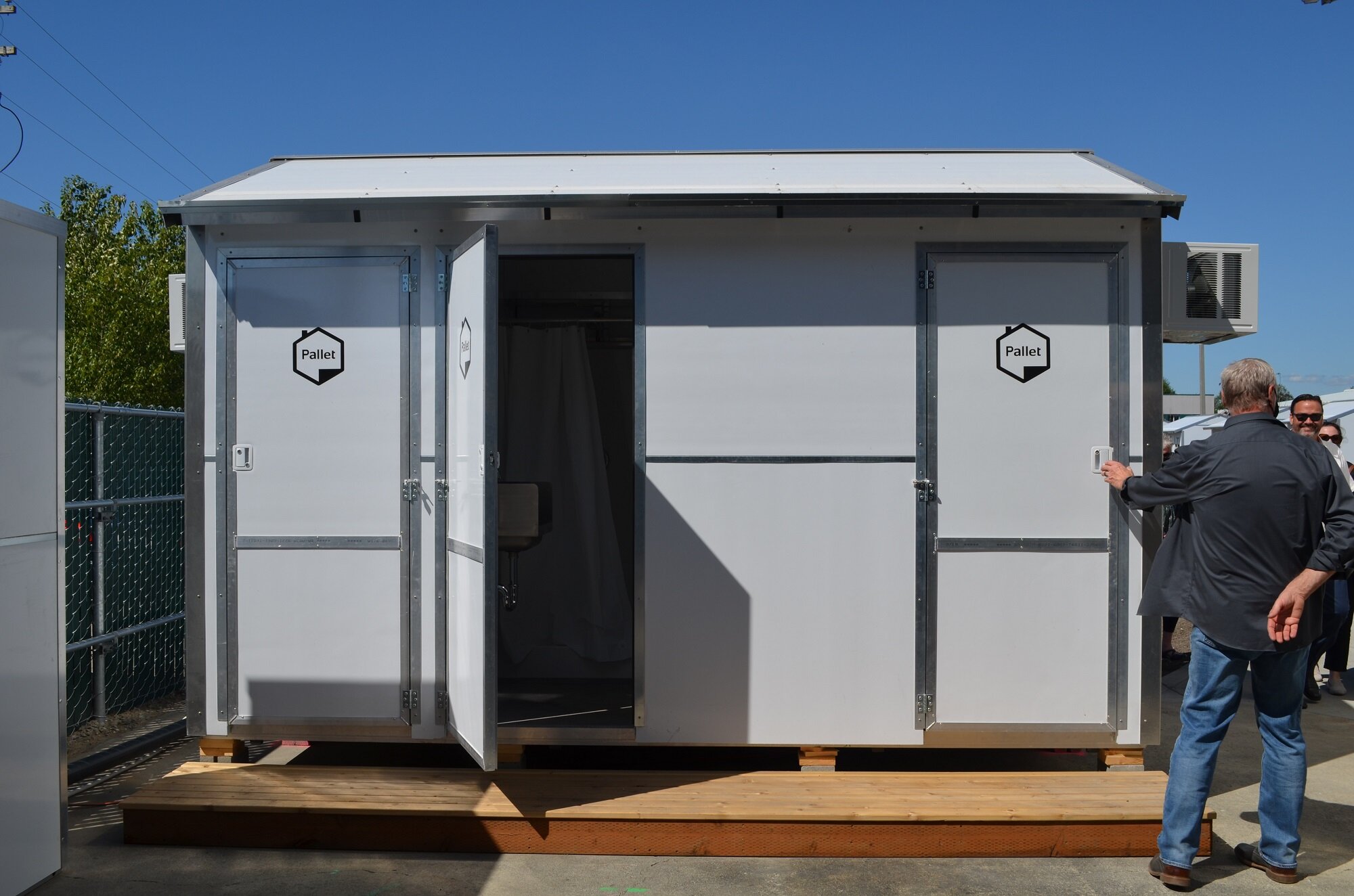
The site is also using our pilot private bathroom and showers.
Skagit First Step Center is located on city-owned property and within driving distance of Pallet’s factory headquarters. In a short time, crews rebuilt a vacant gravel lot into a community. The site is fenced, and each shelter sits on a concrete pad. Officials also renovated an adjoining building on the lot to create office space for staff and a meeting space for residents.
This shelter village is the result of a community effort zeroing in on finding an additional way to address homelessness — an issue that can often seem insurmountable. Skagit County, a few neighboring cities, and private individuals collectively contributed more than $500,000 of funding to the project. The new village joins many other Pallet communities across several states. Our model of combining transitional housing with wraparound services leads to positive outcomes. For example, 41 people who stayed at Riverside Cabin Village Shelter have moved onto permanent housing.
For Tina Tate, Executive Director of Friendship House, the shelter village is another avenue to fulfill their mission.
"It's been about six years that I've had a vision of a low barrier shelter that would serve the most vulnerable, our neighbors living on the streets and give them a place of hope,” she shared. “But Mayor Sexton's vision — this — is better than anything I ever dreamed of. So thank you. Thank you all for being here and having compassion in your hearts and believing that something like this can work.”
RELATED POSTS:
The streets can’t be a waiting room. Why Pallet is one solution to unsheltered homelessness
Pallet employee Josh thought the life he has today was out of reach
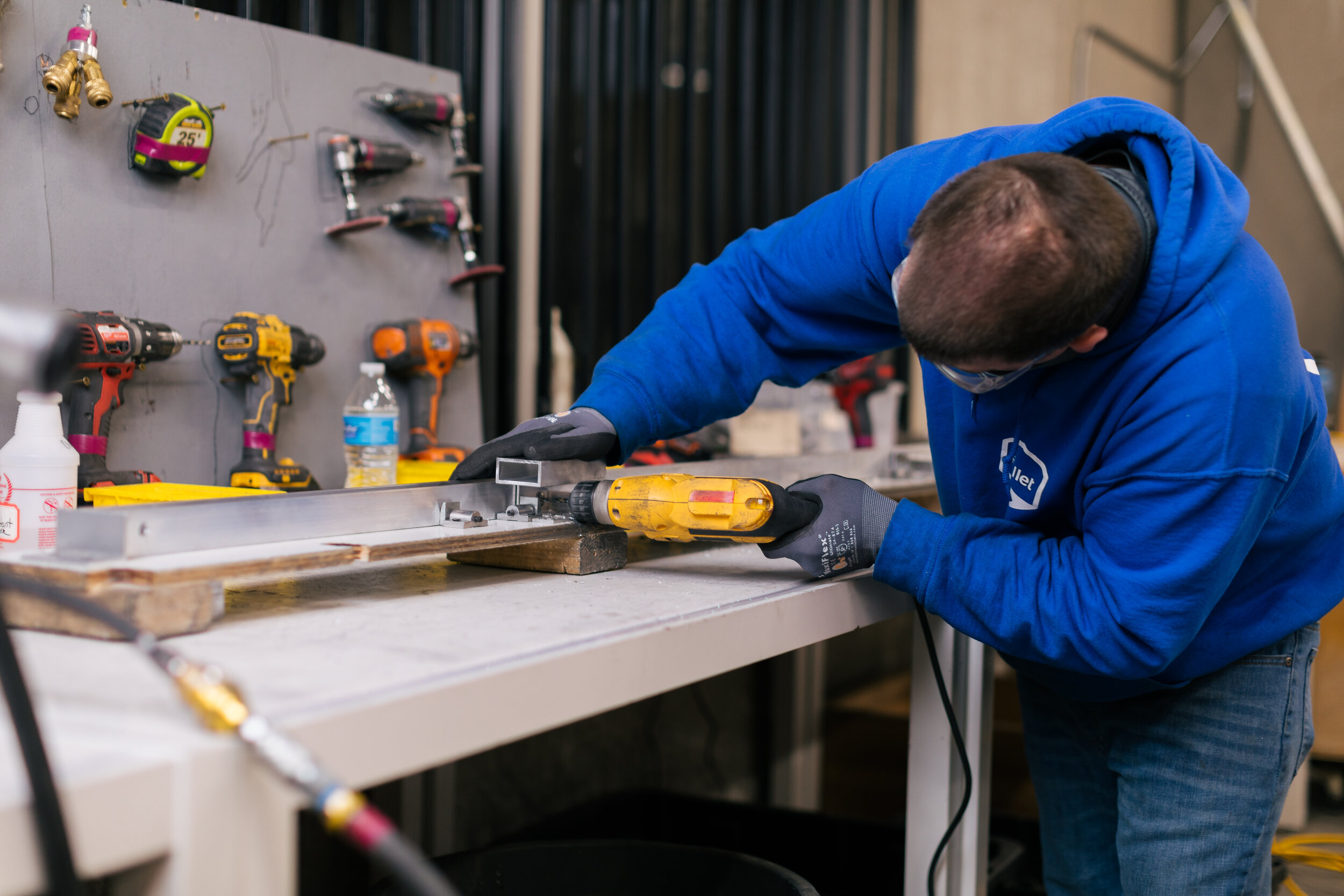
A Pallet employee works on a shelter.
Classifying ourselves as a Social Purpose Company (SPC) is more than an official designation. It speaks to Pallet’s values and purpose. SPC is the Washington state equivalent to a B corporation. It means our team puts a social purpose above making a profit. We're on a twofold mission: build equal opportunity access to housing and employ a nontraditional workforce.
Our shelters are used to create transitional villages for people experiencing unsheltered homelessness. Wraparound case management provided by a local service provider helps them stabilize to move onto permanent housing successfully. It's a proven model assisting people in many cities, including Riverside, California, Tacoma, Washington, and Dallas, Texas.
We employ a nontraditional workforce to meet the goal of ending unsheltered homelessness. Many on our staff have lived experience with homelessness, substance use disorder, and incarceration. At Pallet, employees earn a living wage and receive benefits. From the beginning, our team has informed the design of the shelters and continues to suggest revisions where needed. We've created a supportive community where all can thrive and create the life they want. Employment is a critical component to a sustainable movement out of homelessness.
Becoming a SPC also ensured the investors who join us are mission-aligned. Pallet and the board of directors intentionally invest profits back into the people.
You may be wondering why we aren't a nonprofit. We recognized the scale needed to be successful required a market-based solution. So we brought on partners to front-load the resources required to rapidly meet the needs of the ever-growing homelessness crisis across the country. Doing so allowed us to buy materials, secure a factory, hire staff, and more. The stakeholders on this journey understand Pallet is a social enterprise with the mission being the driving force, not substantial returns on profits.
Further, being a SPC improves our resilience. Unlike a nonprofit, we aren't dependent upon charity and the economic climate. Because of this model, we can currently build 50 shelters a week. That means more people will have access to transitional housing and a path out of homelessness. At the same time, our manufacturing specialists can continue to have access to economic opportunity and stability.
At Pallet we believe a company can pursue profits and carry out a social purpose. The two don't need to be competing forces. We’re leading by example.
RELATED POSTS:
Pallet employee Josh thought the life he has today was out of reach
Los Angeles Opens Its First Shelter Village
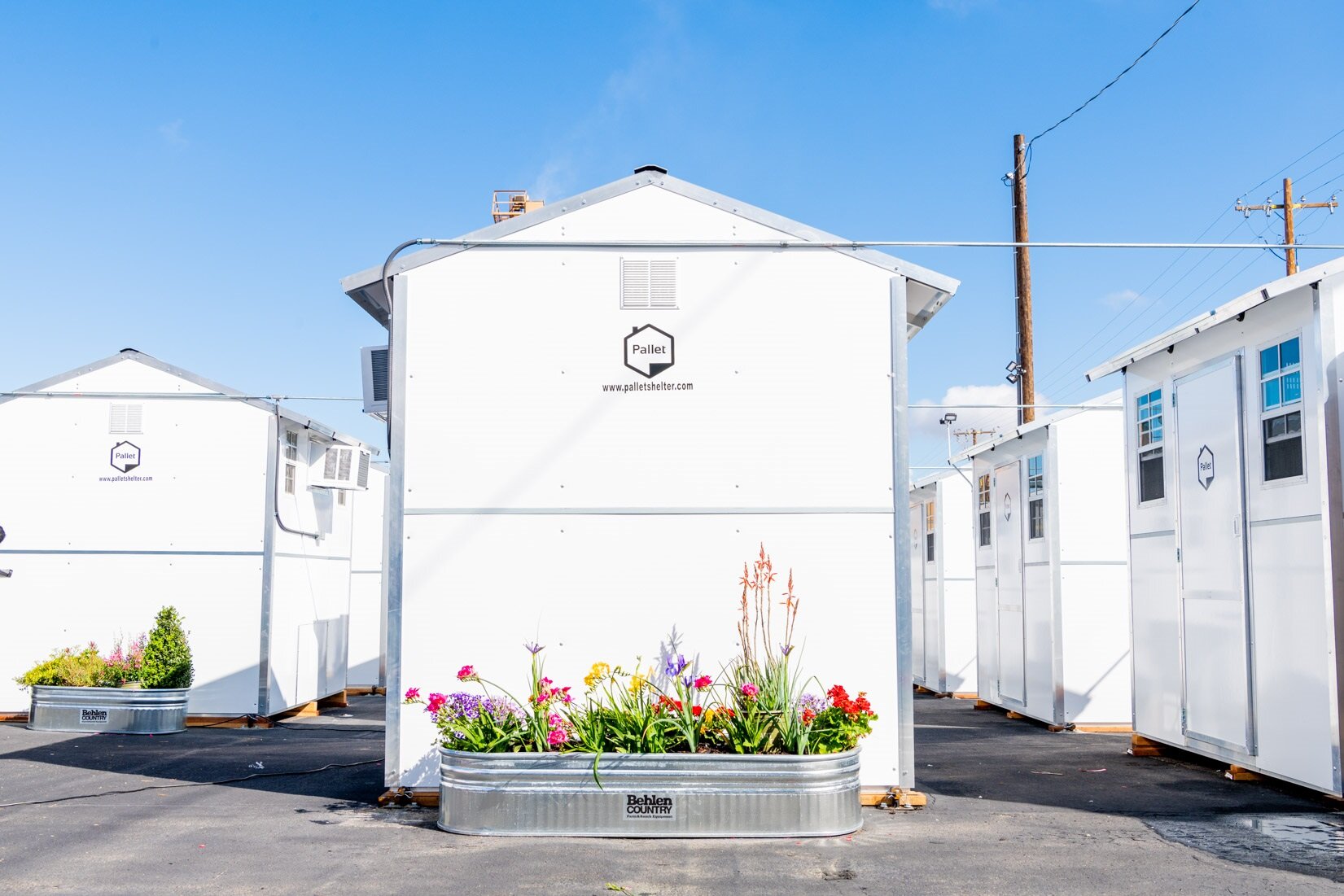
Pallet shelters at Riverside Cabin Village Shelter. Photo courtesy City Net
Moving out of homelessness is complex, and the path to stability varies from person to person. However, one proven factor in improving the odds of long-term success is transitional housing. Riverside Cabin Village Shelter offers this critical step with Pallet shelters.
The southern California community opened in March 2020 with 30 shelters. City Net, a nonprofit organization addressing homelessness through the coordination of community efforts, is the service provider. They’ve partnered with the City of Riverside. Residents have access to 24-hour wraparound services, including program supervisors, case managers, and housing navigators. Meals are also provided.
Riverside Cabin Village Shelter has four ADA-compliant units, dining areas, showers, restrooms, a pet area, bike racks, and a resource center for program participants. In addition, each shelter has a locking door, personal climate control, windows, and more.
Celebration and community are two cornerstones at Riverside. Part of the process of getting back on track is securing lost identification from social security cards to birth certificates. When they arrive in the mail, it’s celebrated. Receiving a housing voucher is also a joyous time. People staying at Riverside form friendships and support one another as they reflect and make plans. Rather than site staff, residents develop their own ideas for activities — one being the construction of vision boards, a collage of images affirming one’s desires and dreams. Everyone staying at Riverside wants to be there and to be self-sufficient.
March 16, 2020 - April 30, 2021 impact:
● 149 people served
● 49 people received tenant-based rental assistance (TBRA)
● 41 people permanently housed
● 25% increased their income
● 3 people reunified with family
Success story:
Born and raised in the City of Riverside, Danielle grew up in a broken home. This lack of stability and familial support contributed to her falling into homelessness. Danielle was enrolled into the Riverside Cabin Village Shelter in September of 2020 and immediately got to work with her City Net Case Manager, working towards her personal goals of increasing employment and ending her homelessness. With the help of her Case Manager, Danielle located a rental unit near her place of employment to increase her hours of work and monthly income. Once approved for her new apartment, City Net helped her with the move-in process and provided her with a deposit and first-month rental assistance. Danielle has remained housed since January of 2021.
We’re excited for Danielle and what’s to come for her in the coming years. Moving into a supportive environment helped her reach her goals.
Too often, people experiencing homelessness are considered lost causes, but that’s not the case at the Riverside Cabin Village or any other Pallet shelter village. Any one of us could succumb to circumstances that require a helping hand. We’re proud to partner with City Net and the City of Riverside to support our neighbors in need.
RELATED POSTS:
Green energy powering Santa Clara County Pallet shelters
Why People Experiencing Homelessness Don’t Accept Shelter

Josh works on a Pallet shelter. Photo by Joe Tobiason
On a recent sunny spring weekend, Josh and his fiancée exchanged I do's in an outdoor ceremony. The two pledged to be life partners in front of a small group of friends and family. The joyous occasion marked a milestone for Josh he would not have predicted for himself. Several years ago, he was sleeping in his car in the back of a store parking lot. Today he maintains a full-time job here at Pallet, mended fractured personal relationships, and tries to lead by example.
"If you told me almost eight years ago when I got clean, that this is where my life would be, I would not have believed you," Josh shared. "I wouldn't believe you, that I have been with the company for almost four years. I wouldn't believe you, that a woman is head over heels for me and wants to marry me."
Josh is grateful for being able to shift the direction of his life. As a second chance employer, his arrest record and past with substance use didn't matter to Pallet. He had construction skills and a strong desire to be a part of an unsheltered homelessness solution. Along with all our employees, Josh earns a livable wage and receives benefits, including a 401k plan. He was one of the first people to join the Pallet team. Josh works in the factory, constructing shelter panels that we ship out to various cities across the country. Building shelter for people experiencing homelessness is personal because he was homeless for five years.
"The past four years have been the best thing in my life. I wouldn't change any of this because I'm building shelter for people that don't have one," Josh said. "We're doing what we're talking about. We're trying to get everybody off the street, and that's all I care about."
“We’re doing what we’re talking about. We’re trying to get everybody off the street, and that’s all I care about.”
The Journey
Josh grew up in the Seattle area and is the middle child among seven children. He began using substances as a teenager. Within a few years, he got into trouble with law enforcement and began using harsher drugs. Thus, starting a cycle of using substances to self-medicate. He surrounded himself with people who were also engaging in the same activities. It was a downward spiral, "I started losing jobs left and right, being homeless. I started stealing from my family and stuff, and so they didn't want me in the house for years."
Even after moving on, one visceral memory remains — the scent inside his car when he lived in it.
"The window was broken out, and I had plastic on it and the smell of the mold and body odor. I'll never forget that in my life of how bad it smelled," Josh shared. "But I was so used to it; I was so used to being in the filth that it was OK."
Josh would eventually get rid of that car because he kept getting arrested for driving on a suspended license. A judge threatened him with a habitual offender charge which led him to the decision. Later, he sought help at Everett Gospel Mission, a nonprofit organization providing shelter and comprehensive recovery programs. Initially, he used it as a place to sleep while the counselors encouraged him to join a program. Josh thought he could quit at any time until he realized he had a problem.
"I finally broke down and went to the counselor, and I was like, look, I need to change something," Josh said. "I don't know what it is, but I need to change it."
It took a few starts and restarts, but with the Genesis program's help at Everett Gospel Mission, Josh finally began to stay on track.
Josh says he's always done construction work because he was good with hands. Since joining Pallet, Josh has improved his reading and writing skills with the assistance of Zane, Director of Engineering. One of Zane's techniques was having Josh write things down rather than relying on his memory.
"He was pushing me, and I don't think he realized how much he was affecting my life," Josh shared. "Helping me to encourage myself to just step forward and just keep on working on it and it'll come eventually."
The challenge has paid off outside of work as well. Josh is reading books now and isn’t relying on voice text.
Reflections
Ending homelessness is often framed as meeting physical needs — getting a roof over someone's head and into a stable environment. For Josh, it was more nuanced. First, he had to move out of his comfort zone and accept that it was time to take on responsibilities, such as paying bills on time. He also had to get past doubt and negative self-talk. He would say to himself that he would screw up again and that he wouldn't make it, so why even try.
"Trying to come out of it was the hardest thing I ever did in my life," Josh said. "It was even harder than quitting drugs."
“Trying to come out of it [homelessness] was the hardest thing I ever did in my life. It was even harder than quitting drugs.”
Doubts still creep up from time to time, but now he has the tools to combat them. One strategy is going through a list of five things he's grateful for, which centers him.
Josh uses his journey as a testimony to help others. His affable nature and positive attitude make him easy to talk to. He also tries to be a role model at work.
"I try and be that every single day because I don't know who's struggling, who's not. I don't know if somebody needs to be talked to, nothing. So I'm always having that open heart. Always. And I always will be, you know, for the newcomer or anybody struggling."
RELATED POSTS:
Daniece Experienced Homelessness, Now She's Working to End It
Why People Experiencing Homelessness Don’t Accept Shelter
Green energy powering Santa Clara County Pallet shelters
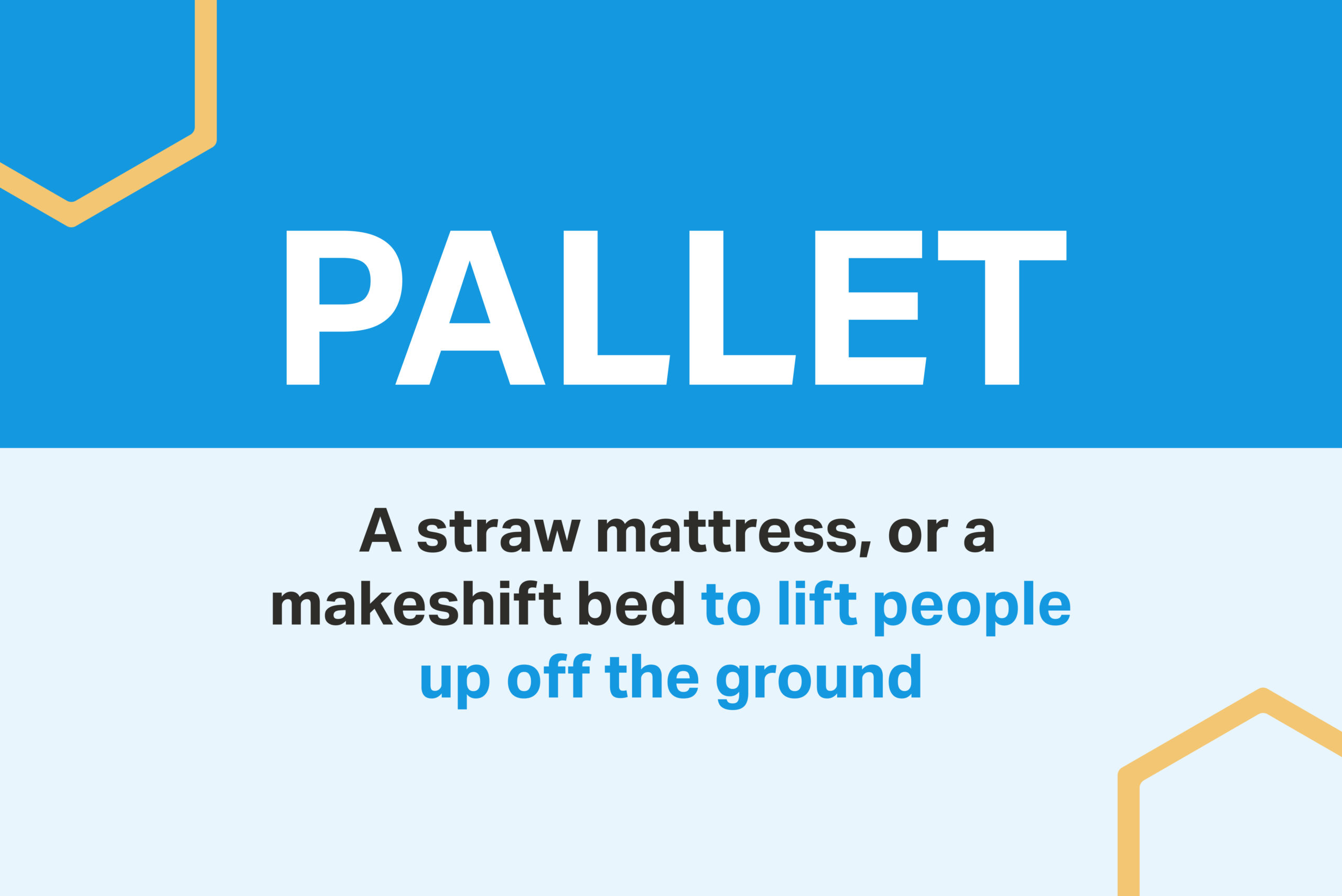
When you first hear our company name, the first image that comes to mind is often wooden planks forged together. It's an understandable reaction given what the word has come to represent over time. But unlike wooden shelters, ours are made of durable FRP panels that are resistant to mold, mildew, and pests. In one sense, Pallet is indicative because we stack each shelters' panels, place them on a pallet, and then ship them to destinations across North America. Pallet speaks to the functionality of our innovative solutions to human displacement. But that wasn't enough. Our name needed to reflect our values.
The driving force behind choosing the name is Pallet Founder and CEO Amy King, a self-described "linguistic nerd." She loves words and definitions, leading her to a name that reflects our mission as a whole. The early definition of a pallet is a straw mattress, or a makeshift bed to lift people up off the ground. When someone has a bed and a safe space to sleep, it allows them the opportunity to rest and plan their next steps. This is crucial for people experiencing displacement. One cannot start to improve their circumstances without having basic needs addressed. Our shelters lift people up because they offer dignity, a locking door, storage, personal climate control options, and more. They are built in a village setting to form a community where people can access wraparound services, develop camaraderie with other residents, and make positive transitions to more permanent housing.
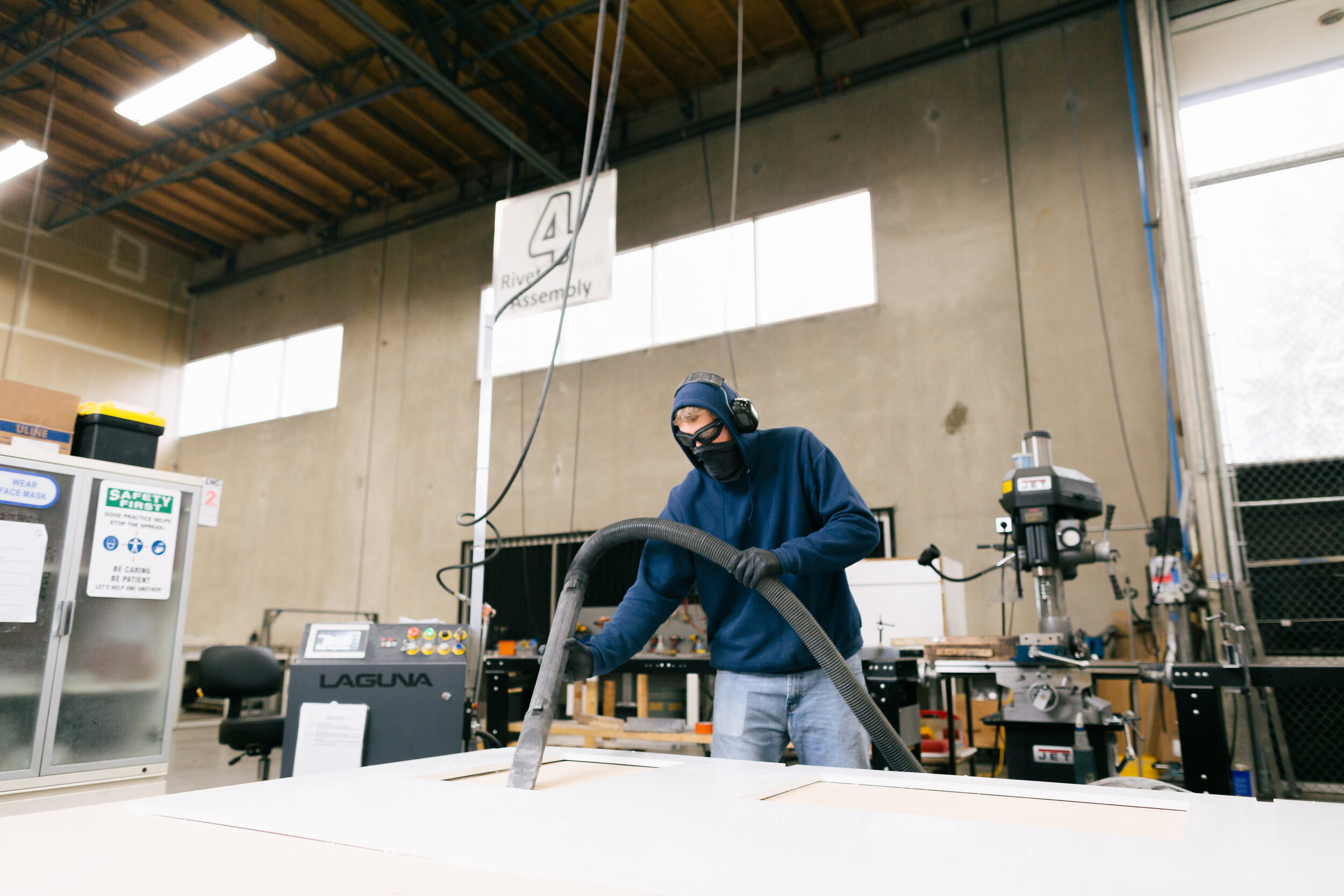
A Pallet employee works on a shelter.
Pallet as a name is also a reflection of our commitment to elevate our employees who build the shelters. We are a fair chance employer, which means we hire and invest in people actively engaged in recovery and reintegration. Some have lived experience with homelessness and are invaluable in the design process of our shelters. We offer competitive wages, healthcare, and a 401k plan — benefits that speak to our commitment to creating supportive spaces to heal and foster community.

Tents line a sidewalk in Seattle’s Pioneer Square neighborhood. In 2020 Washington state experienced a 20 percent increase in homelessness among families with children. File photo.
At the end of the month, the federal eviction moratorium issued by the Centers for Disease Control and Prevention (CDC) is set to expire. The looming deadline coupled with a new homelessness report from the Department of Housing and Urban Development (HUD) is concerning. The annual Point-In-Time (PIT) count data reflects information collected before COVID-19 swept the nation.
For the first time since data collection began, more people experiencing homelessness were unsheltered, meaning they stayed on the street, in abandoned buildings, or other places unfit for human habitation — than were sheltered. Unsheltered homelessness increased by seven percent, while the sheltered numbers remained steady. In Arizona, Arkansas, California, Hawaii, Nevada, and Oregon, more than half of the homeless population comprises people living in unsheltered locations.
This is an alarming benchmark because people living outside are at higher risk of experiencing violence and trauma. They are also more reliant on public and emergency health systems for care. COVID-19 has only exacerbated the homelessness crisis. The pandemic has created job losses and increased demand for the services such as food banks.
Key Findings from HUD’s 2020 annual homeless assessment report part one:
● On a single night in January 2020, 580,466 people – about 18 of every 10,000 people in the United States – experienced homelessness across the United States. This represents a 2.2 percent increase from 2019.
● After steady reductions from 2010 to 2016, homelessness has increased in the last four consecutive years.
● Veteran homelessness did not decline in 2020. 2020 was the first year that homelessness among family households did not fall since 2010.
● Youth homelessness is slightly down (a 2.2 percent decrease from 2019).
● People of color are significantly over-represented among people experiencing homelessness.
In a video address, HUD Secretary Marcia L. Fudge referred to the findings as devastating. She also spoke about how people can be helped, “It has been shown, time and again, that helping people exit homelessness quickly through permanent housing without restrictions, prevents a return to homelessness.”
But it’s not all bleak news. Help is on the way for people experiencing homelessness. The America Rescue Plan Act, signed by President Joe Biden, allocates $5 billion for emergency housing vouchers and $5 billion to help create housing and services for people experiencing or at risk of homelessness.
At Pallet, we contribute one solution to getting people off the street and into permanent housing. Our shelters are a safe and dignified place of transition until they can find a home of their own. The shelters are designed by people with lived experience who uniquely understand the needs of those who are living unsheltered.
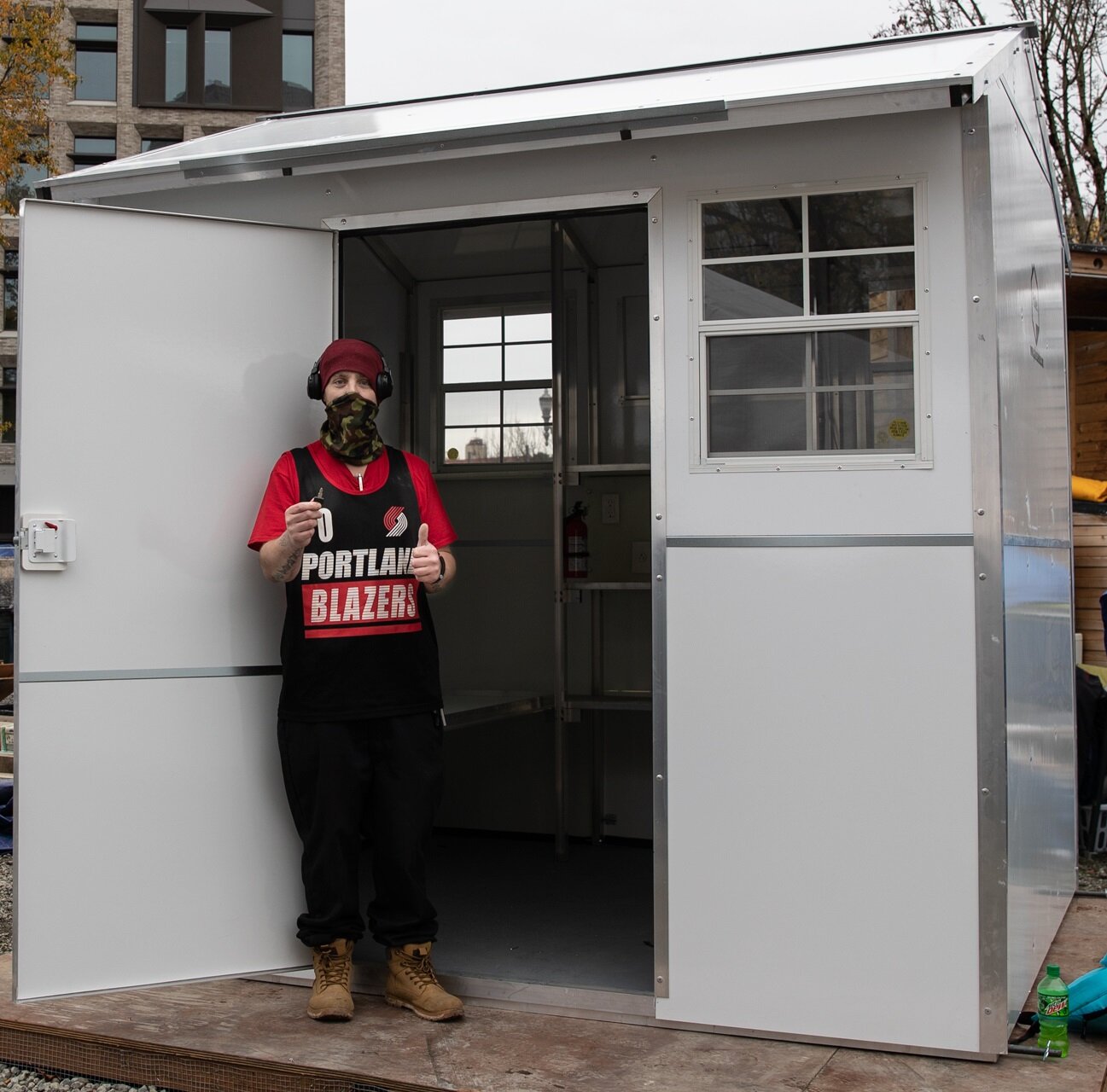
CP3O Village in Portland opened in November 2020. A resident holds up a key to the Pallet shelter they’re going to stay in temporarily. Photo credit: Multnomah County
Pallet began with a two-fold mission: end unsheltered homelessness and build a workforce of people impacted by the criminal justice system. The shelters we manufacture allow us to do both. Cities and counties that want to address the homelessness crisis buy our shelters to create a transitional housing village. A local social service agency manages the site — giving people living there access to services crucial to regaining stability. Our staff who manufacture the shelters work in a supportive, purpose-driven environment.
Highlights from 2020 include: creating dignified shelter beds in 21 cities, keeping our employees working during a time of record job loss, and offering a way for elected officials to continue to respond to the homelessness crisis during the COVID-19 pandemic.
For more information, check out our full impact report below.
